In the heart of the Alpilles, Les Baux-de-Provence is a picturesque emblem of medieval heritage and natural beauty. I have been to Les Baux several times and somehow managed to escape the crowds by avoiding the high season.
This enchanting village, perched atop a rugged limestone outcrop, offers breathtaking views of the Alpilles mountain range and a journey through a rich tapestry of history. Once home to a thriving community of over 6,000 people in the Middle Ages, today Les Baux-de-Provence captivates with its serene atmosphere, housing just a handful of permanent residents within its ancient bounds.
Its cobbled streets, lined with Renaissance mansions and shadowed by the majestic ruins of its castle, whisper tales of lords and legends, including the audacious lords of Les Baux who claimed descent from one of the Magi, Balthasar.
The Château des Baux, with its medieval siege engines and troglodyte dwellings carved into the rock, stands as a testament to the village’s glorious past, inviting visitors to step back in time.
Awarded the title of “Most Beautiful Village of France,” Les Baux-de-Provence is not just a destination but an experience, offering a stunning panorama that has inspired artists and stroke visitors for centuries.
Watch a short video presentation of the Alpilles and Les Baux:
Les Baux-de-Provence, a beautiful village!
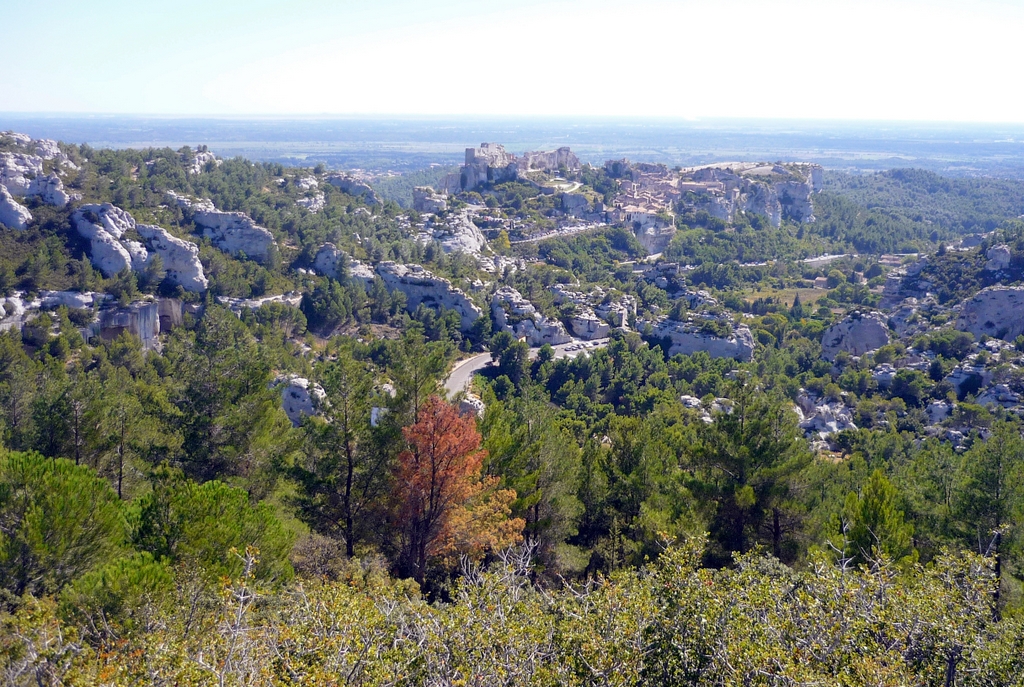
Listed as one of the most beautiful villages of France, Les Baux-de-Provence attracts 1.5 million tourists a year, while it has a permanent population of only 300!
Many of the houses still make for fascinating ruins, which evoke medieval times when the village’s population was as many as 6,000 in the Middle Ages.
The extraordinary site of Les Baux-de-Provence is situated on a spur 700 meters long and 200 metres wide, bordered by two steep ravines.
Where to stay in Les Baux-de-Provence?
To book your stay in the region of Les Baux-de-Provence, from luxurious hotels to guest houses, click on this affiliate link from Booking.com.
Or zoom out on this map to explore all accommodations in the region:
Historic Overview of Les Baux-de-Provence
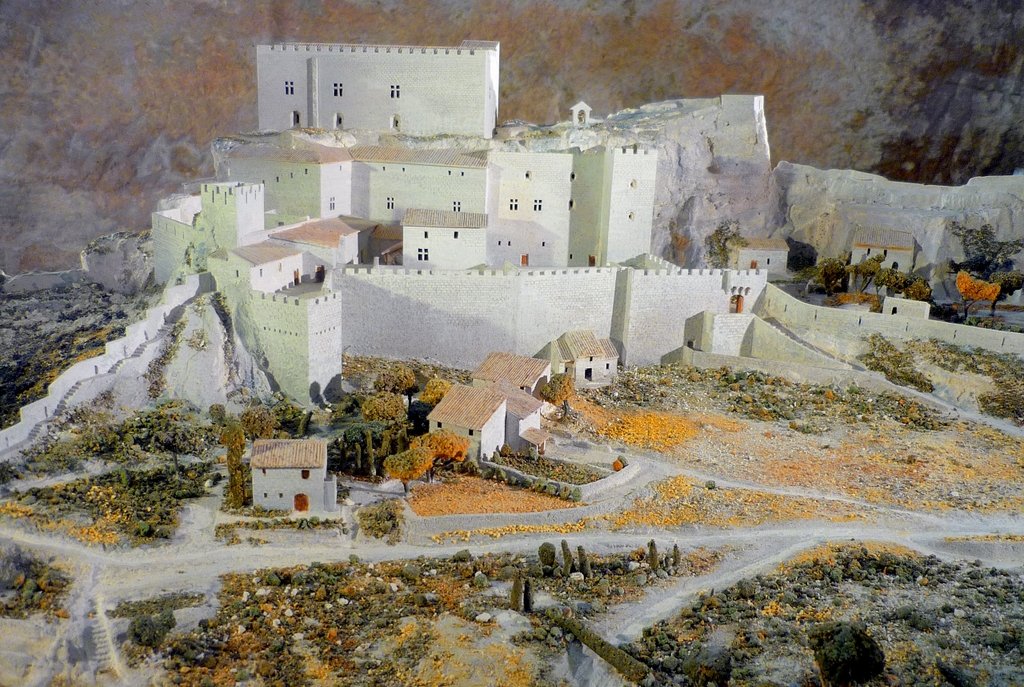
It is believed that human settlement on the site of Les Baux dates back to 6000 BC when it used to serve as a Celtic oppidum. The site itself has a substantial strategic advantage. Thanks to its height, it offers an excellent view of the surrounding countryside and, as a result, offers excellent protection against raids or attacks.
A strategic location for two main advantages
The location of the Baux plateau, naturally perched and secluded, has always provided its inhabitants with a dual advantage: first, the ability to observe the surroundings and second, to protect themselves.
This likely explains why it has been occupied since the Ancient Times and almost continuously to the present day.
The origins of Les Baux
The earliest known texts from the 10th century speak of “Balcium Castrum” or the castle of Balcio.
They mention a lord, Pons le Jeune (Pons the Young), whose descendants adopted the name of Les Baux as their surname.
The lords of Les Baux
But the most exciting part of its history occurred during the Middle Ages when Les Baux was the seat of Baux’s powerful—but rebellious and warring—lords. Poet Mistral said of them that they were “a race of eagles, never vassals.”
Over successive generations, the feudal lordship gained control of 79 towns and fortresses in Provence, Dauphiné and Italy, known as “Terres Baussenques” (Baux lands). From the 11th century, they were among the most powerful feudal lords in southern France.
Claiming to be the descendants of Magus King Balthazar, the ambitious dynasty placed the Star of Bethlehem on their coat of arms and attempted to enforce their authority over Provence.
From 1145 to 1162, they waged war against the House of Barcelona, disputing its rights over Provence.
However, their efforts were in vain, as they had to submit after being besieged in their fiefdom.
For some, the lords of Les Baux became princes of Orange, viscounts of Marseille, and even counts of Avellino and dukes of Andria in Italy, having followed the expedition of the princes of Anjou to Southern Italy.
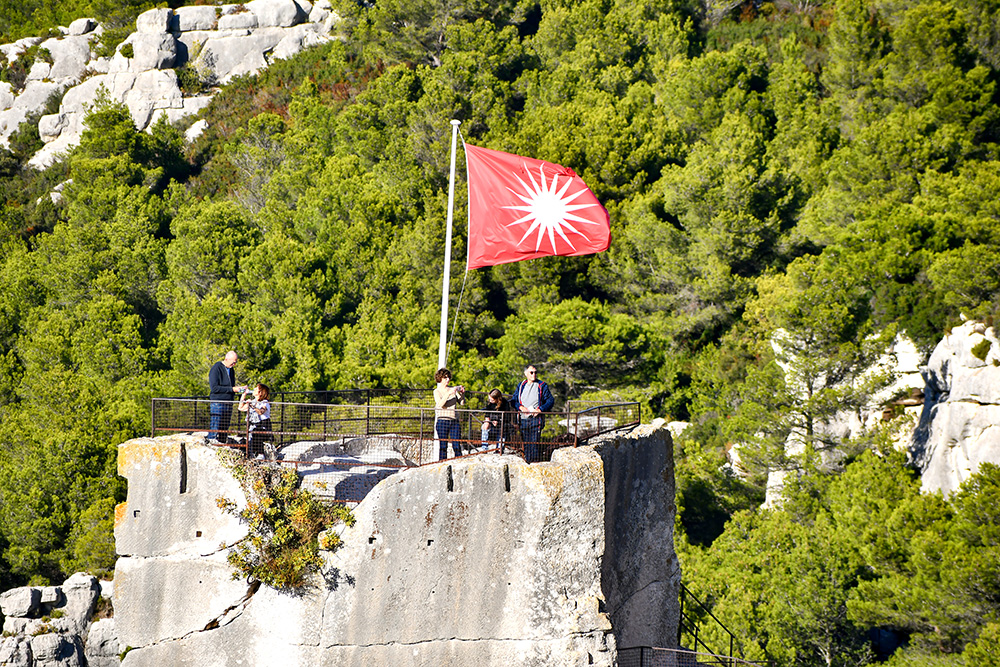
Troubadours in Les Baux
Stories tell of ‘courts of love’ in Les Baux, with troubadours serenading the county’s most beautiful women with their poetry.
Raymond de Turenne, the Scourge of Provence
Both romantics and visitors are drawn by accounts of the fierce actions of the lords of Les Baux, especially the 15th-century Raymond of Turenne, who acted like an outlaw.
This lord of the place was related to two Popes of Avignon. He was nicknamed “le Fléau de Provence” or the Scourge of Provence.
Raymond de Turenne’s favourite pastime was to force prisoners to leap into the void from the top of the castle of Les Baux. Their hesitations and anguish amused him greatly.
Many were undoubtedly relieved by his death in 1413 at the age of 61. No one knows where or how he died. And it’s also unknown where he was buried.
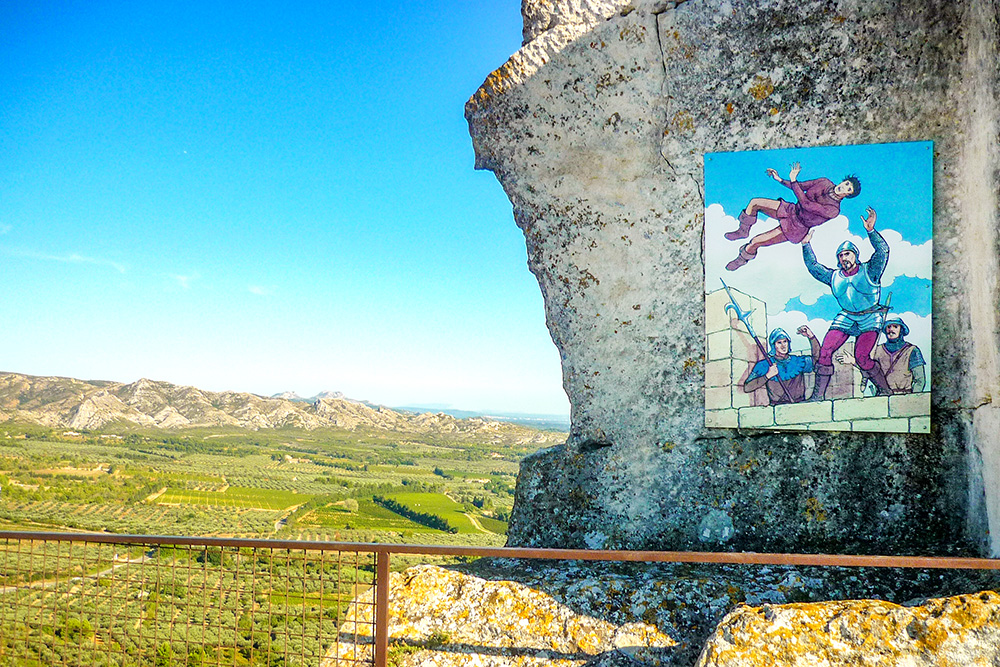
The end of the Lords of Baux
The rule of the strong-minded dynasty ended with the death of Alix in 1426, the last Princess of Les Baux, at which point the “Terres Baussenques” were seized by the Count of Provence, King Louis III of Sicily.
Consequently, when the County of Provence was annexed by the Kingdom of France in 1481, the barony of Les Baux changed its ruler once again and eventually rebelled. The King of France, who feared that his new authority in Provence might not be respected, did not want to risk losing the stronghold of Les Baux to the enemy. Distrusting Les Baux, which had built a bad reputation for rebellions over the years, the King of France, Louis XI, ordered its dismantlement in 1483.
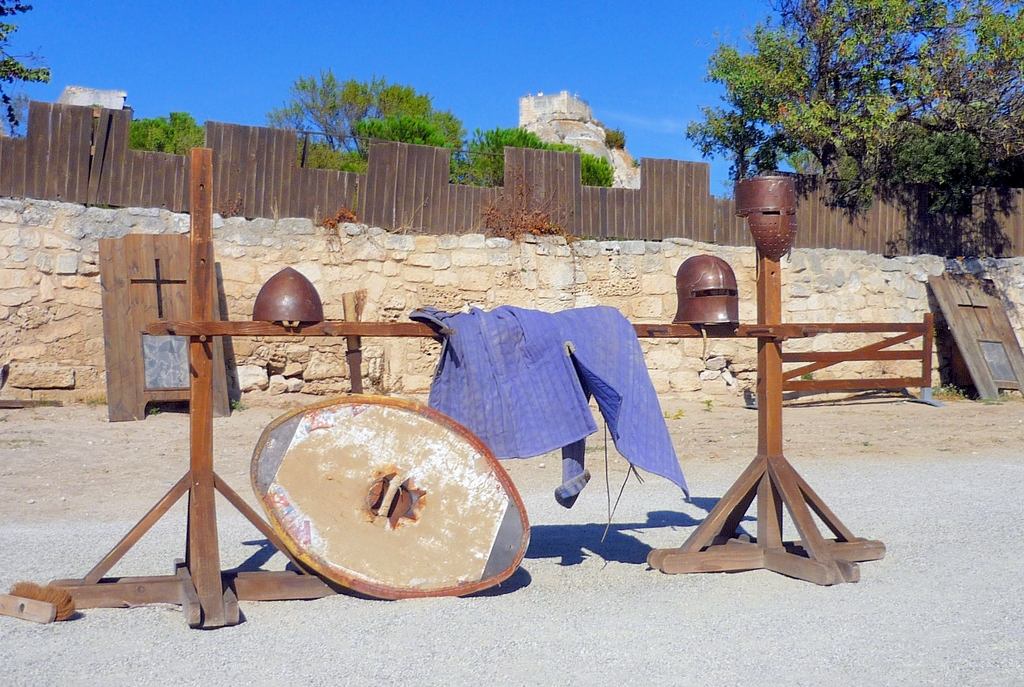
The Renaissance in Les Baux
From 1528, the Constable Anne de Montmorency, who held Les Baux, undertook significant restorations, and the village again experienced a prosperous period.
Then, Les Baux became a Protestant stronghold under the family of Mainville, who administered the barony for the crown of France.
The last siege of Les Baux castle
In 1631, the fortress was again in the hands of the rebels. The royal decision to abolish the Parliament of Provence the previous year provoked a revolt in Aix-en-Provence. Some rebels fled and took refuge in Les Baux.
The town was besieged by the troops of Richelieu in 1632. Following these battles, the fortress was again dismantled, but this time, the castle did not rise from its ruins. Not only did the inhabitants see their fief reduced to ruins, but they also had to pay a heavy fine and demolition costs.
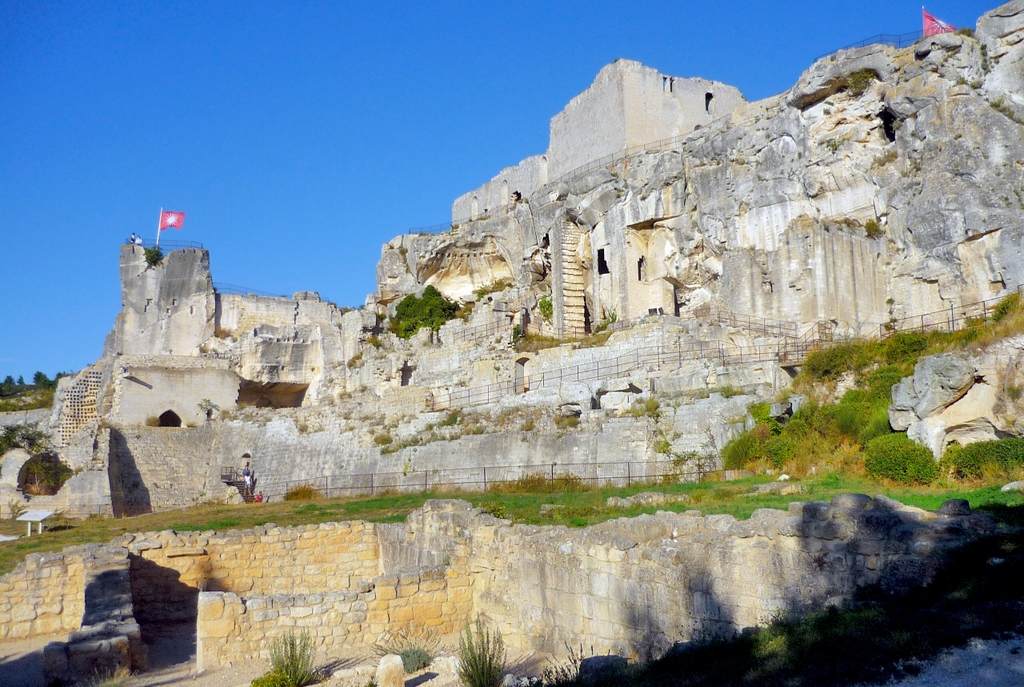
The Monaco Connexion
In 1642, the lordship of Les Baux was given by Louis XIII to Hercule Grimaldi as a thank-you for his policy favouring the crown of France. He passed on the title of Marquis des Baux to his descendants, of whom Prince Albert of Monaco is the current holder.
This explains why there is a Place Prince Rainier III on the site of the Post Tenebras Lux in the village.
Bauxite in Les Baux
The word ‘baux’ comes from the Provençal ‘bàus’, meaning a steep rock.
The village gave its name to the aluminium ore Bauxite when geologist Pierre Berthier first discovered it in the region in 1821. Bauxite was first mined here in 1822, and its extraction ceased in 1990.
The renewal of Les Baux came in the 1950s when Chef Raymond Thuillier opened the famous restaurant Oustau de Baumanière in Les Baux-de-Provence. In 1966, André Malraux signed a decree which placed the entire town under the protection of the Ministry of Culture.
One of France’s most beautiful villages
Les Baux-de-Provence has been awarded the title of “Most Beautiful Village of France.” Les Plus Beaux Villages de France is a French association and a certification mark established in 1982 that encompasses a network of more than 176 villages.
Les Baux-de-Provence is the only village in the Bouches-du-Rhône département to enjoy this prestigious title. Provence boasts 22 villages from the network, including Lourmarin, Roussillon, and Gordes.
Explore Les-Baux-de-Provence
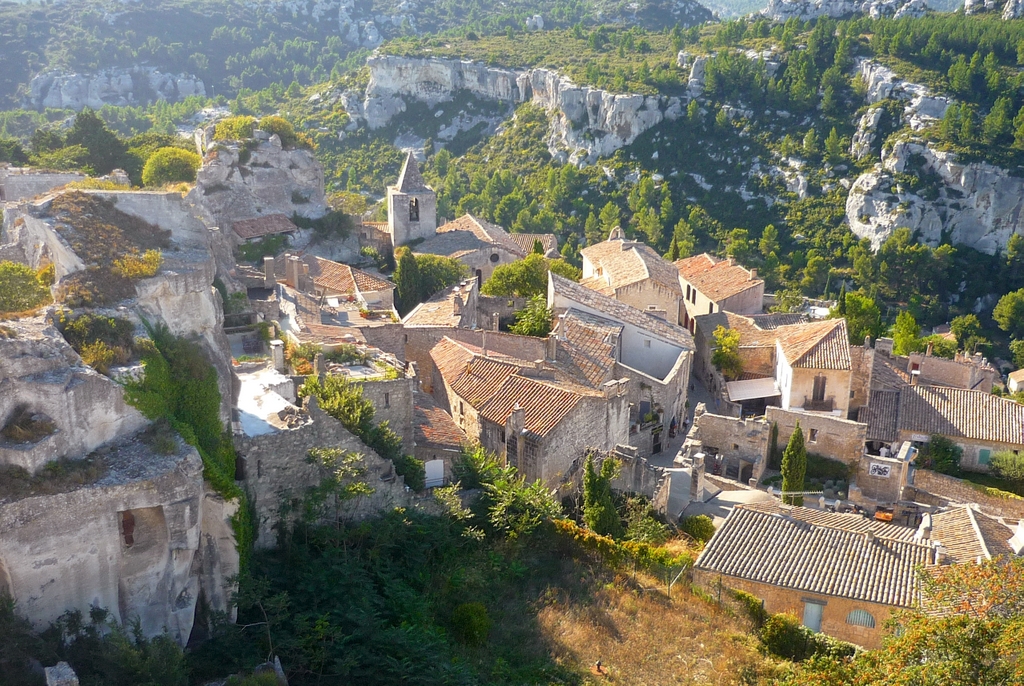
Les Baux can only be visited on foot, which is the best option anyway, to truly discover the village’s many architectural features. Some of these are listed as historical monuments by the French government and have been carefully restored.
These include St Vincent church, the town hall, various Renaissance townhouses (hôtels particuliers) and chapels.
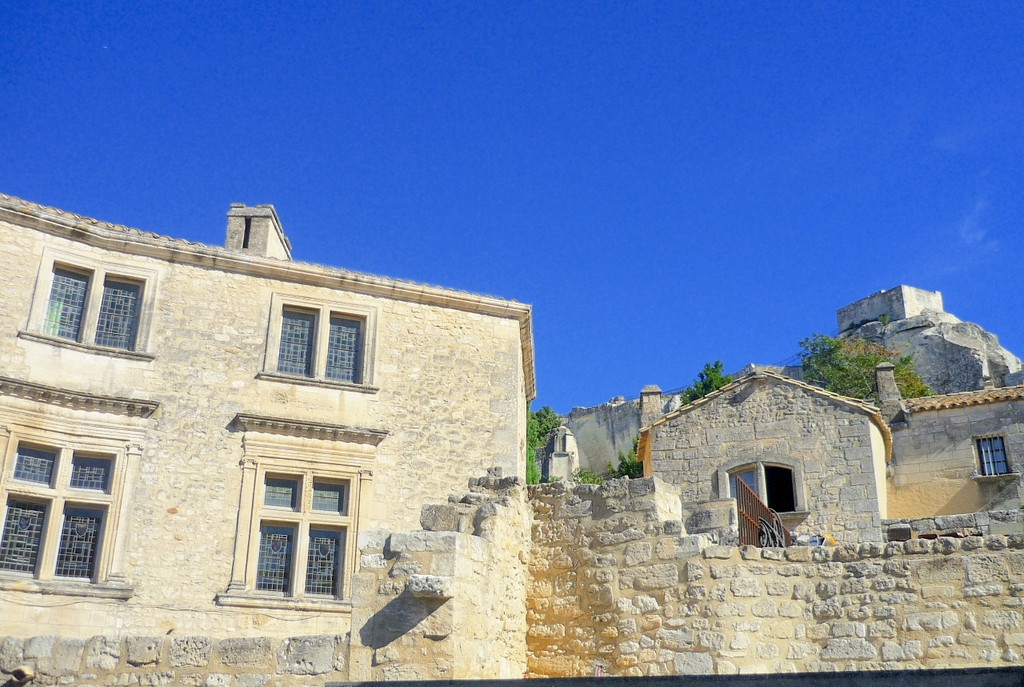
Porte Mage and Maison du Roy
The rampart against which the buildings were constructed was breached in the second half of the 19th century to allow for the opening of the current town entrance. This entrance is known as the Porte Mage.
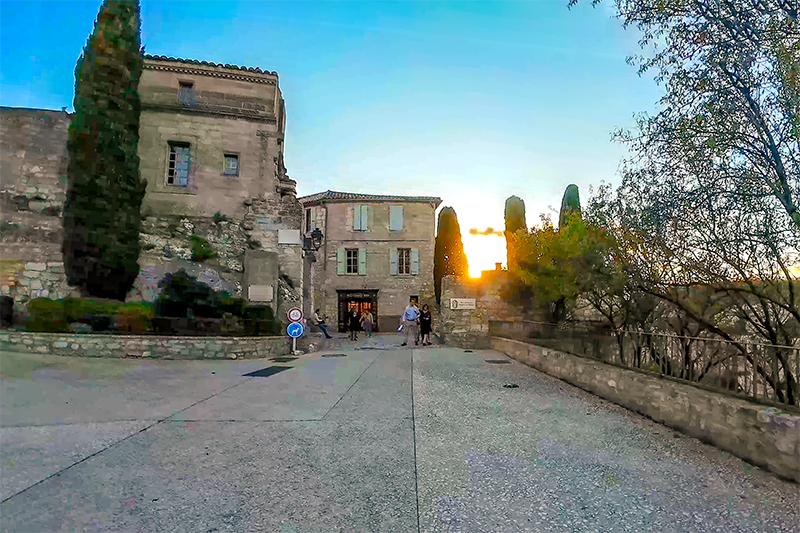
On the right is the Maison du Roy. Until the French Revolution, the town of Les Baux-de-Provence was the capital of a royal and feudal jurisdiction. The seat was long situated in this building, constructed in 1499. Justice was notably administered here in the sovereign’s name.
Today, the Maison du Roy houses the Tourist Office.
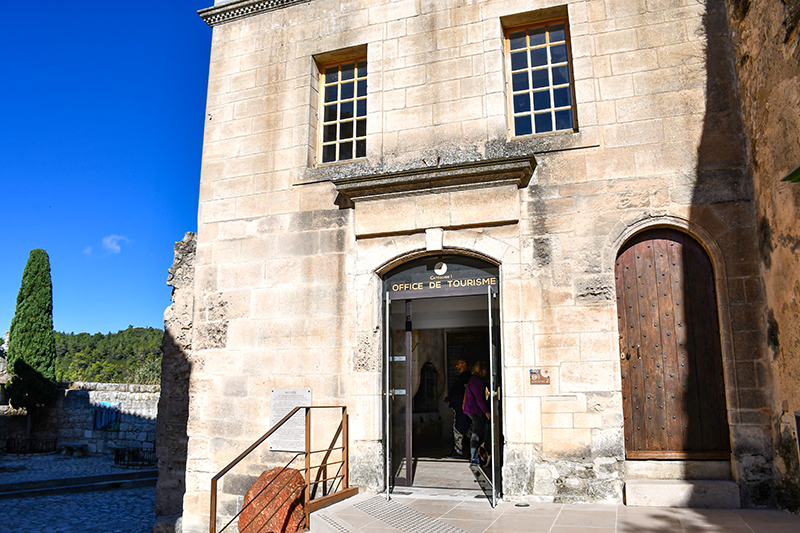
Place Louis Jou
The little square offers a splendid view over the valley of the Vallon de la Fontaine.
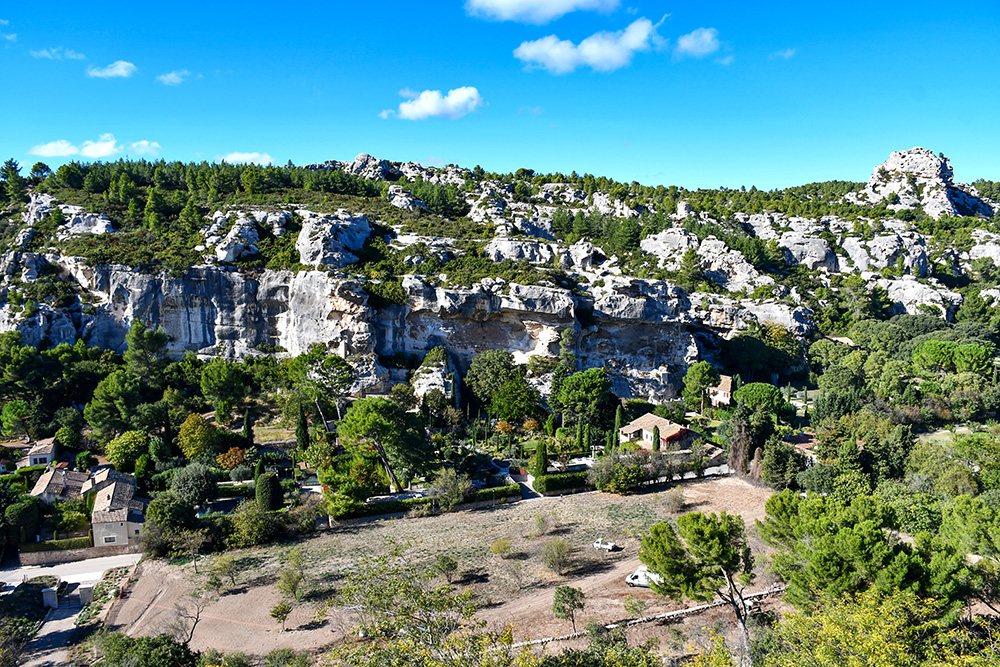
The old guardhouse from the 17th century borders it. It now houses the Santons Museum, where you can admire Neapolitan figurines from the 17th and 18th centuries, church santons from the 19th century, and a traditional Provençal nativity scene.
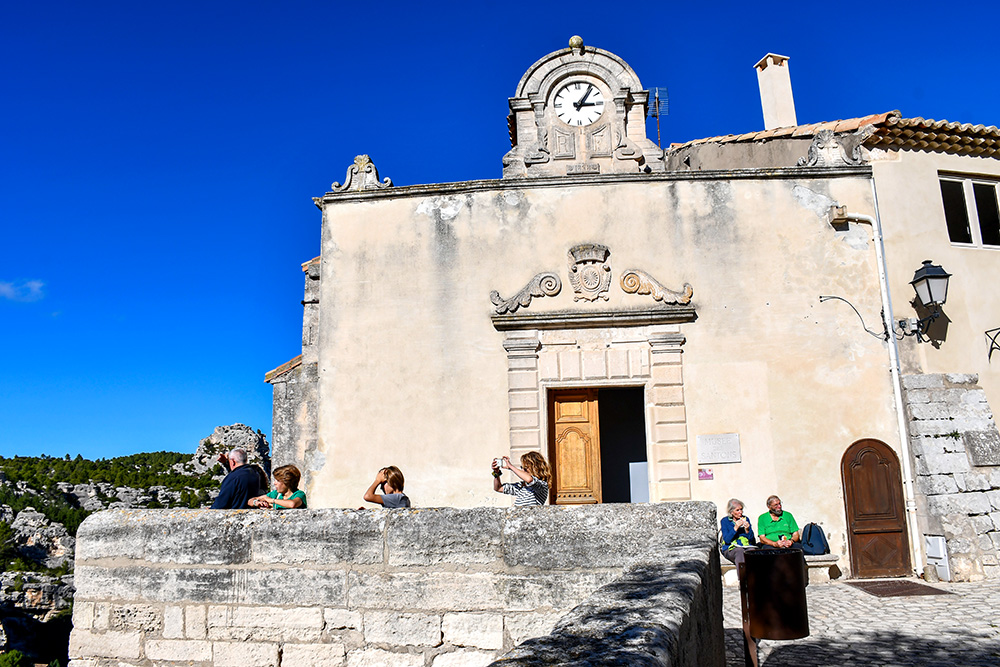
Porte Eyguières
The Place Louis Jou gives access to the Porte Eyguières, the second gateway to the village.
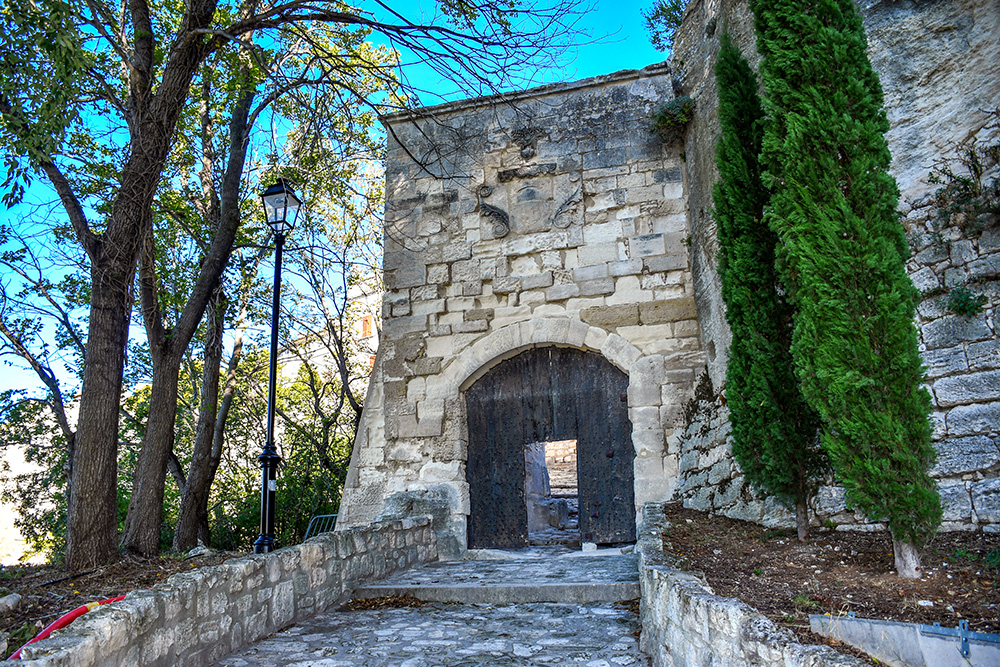
Until 1866, the Eyguières Gate was the only access to the village. Residents would pass through to fetch water from the Vallon de la Fontaine.
Grande Rue Frédéric Mistral
The village’s High Street is lined with tourist shops and Renaissance townhouses, such as the Hôtel Jean de Brion and Hôtel de Manville.
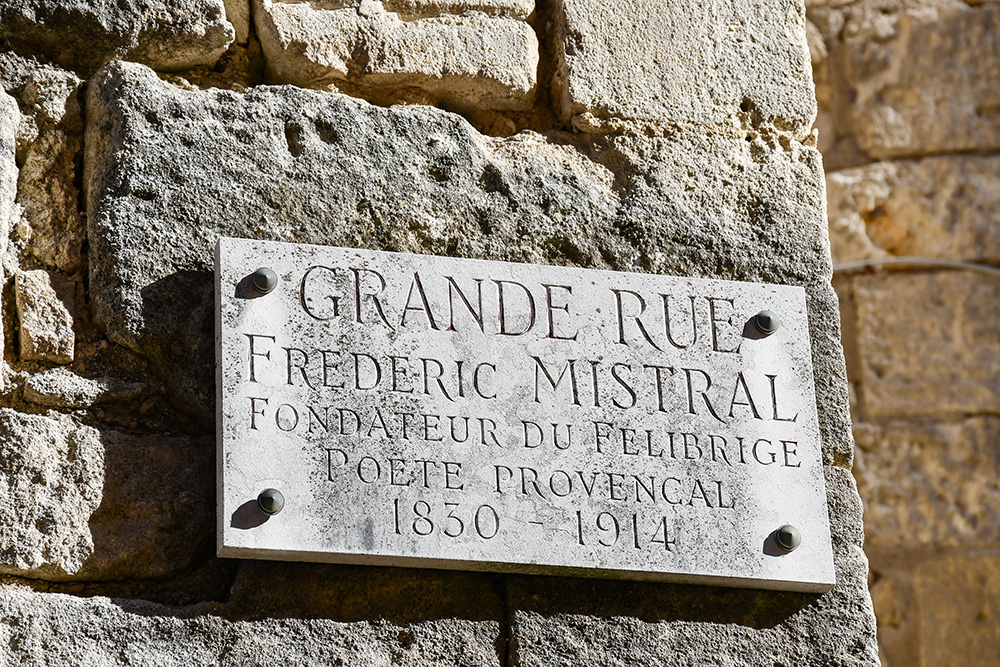

Hôtel Jean de Brion
This private mansion was completely restored by Louis Jou, a painter, engraver, and typographer of Spanish origin who decided to settle here in 1939.
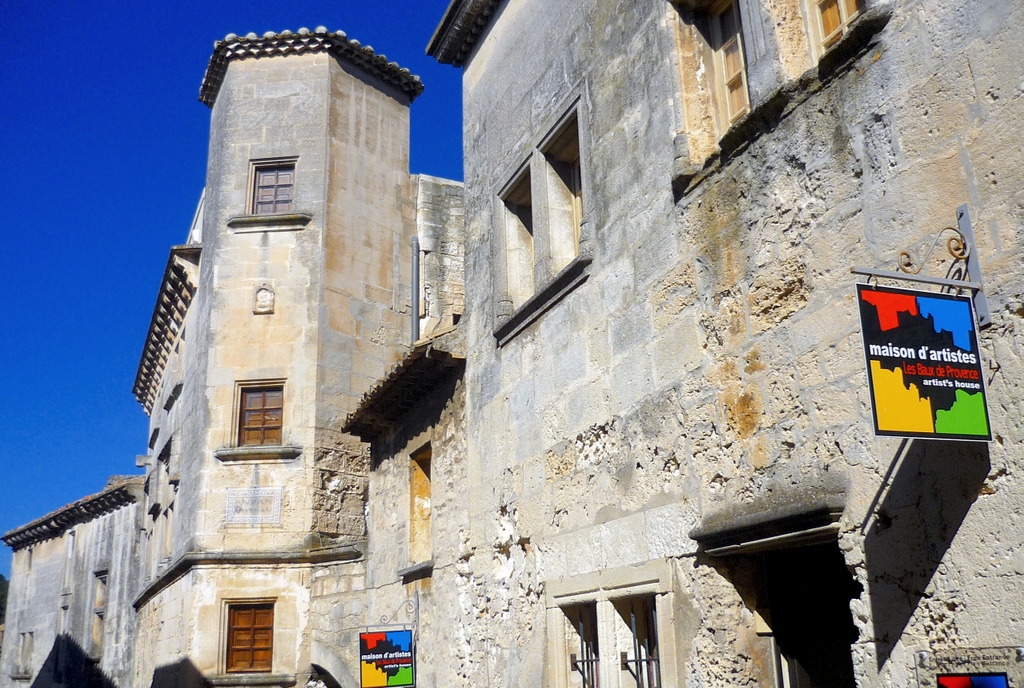
After the death of Louis Jou, the mansion houses the Louis Jou Foundation. In July 2021, the foundation set up on the ground floor, “l’Atelier du Livre,” renowned for the quality of its manuscript, archive, and precious book restorations. On the first floor is Louis Jou’s library, comprising 5000 volumes from the 16th to the 19th centuries, including engravings by Dürer and Goya.
Hôtel de Manville
The Manville townhouse is the most beautiful Renaissance private mansion in Les Baux-de-Provence.
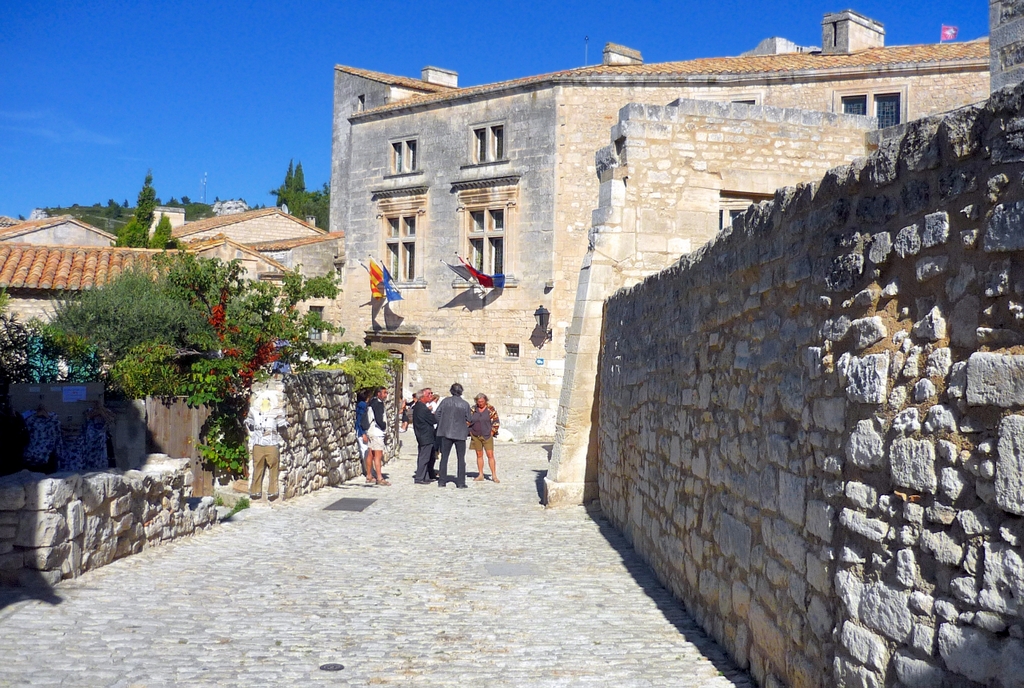
The Manvilles, a wealthy Protestant family, built the residence in 1571. Go inside to admire the old inner courtyard with Renaissance porticos.
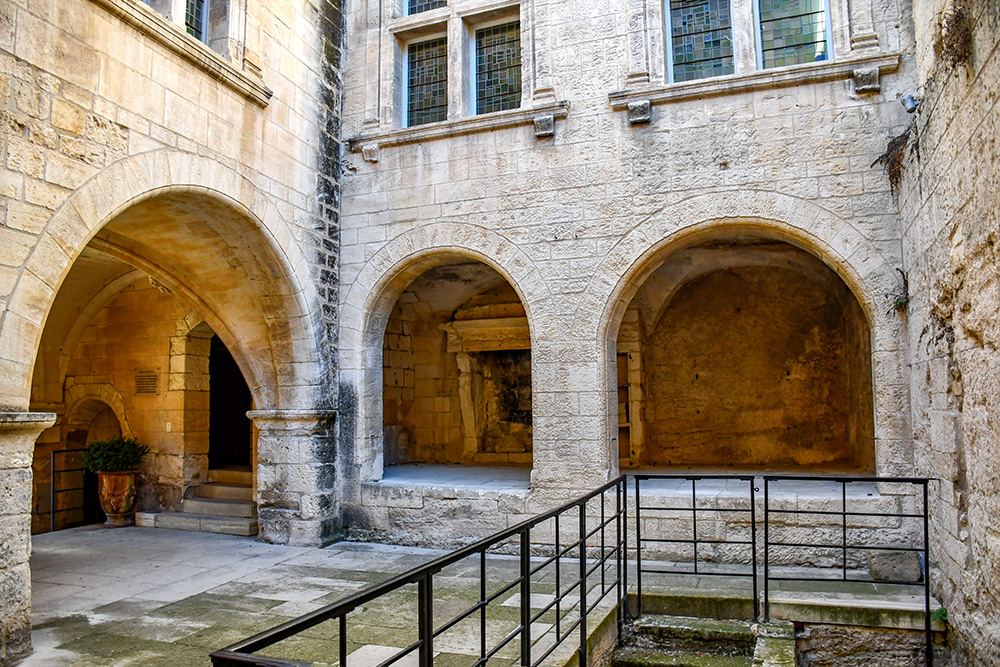
Post Tenebras Lux
Not far from the Manville townhouse are the ruins of a significant residence from 1571: the “Logis de Brisson-Peyre”.
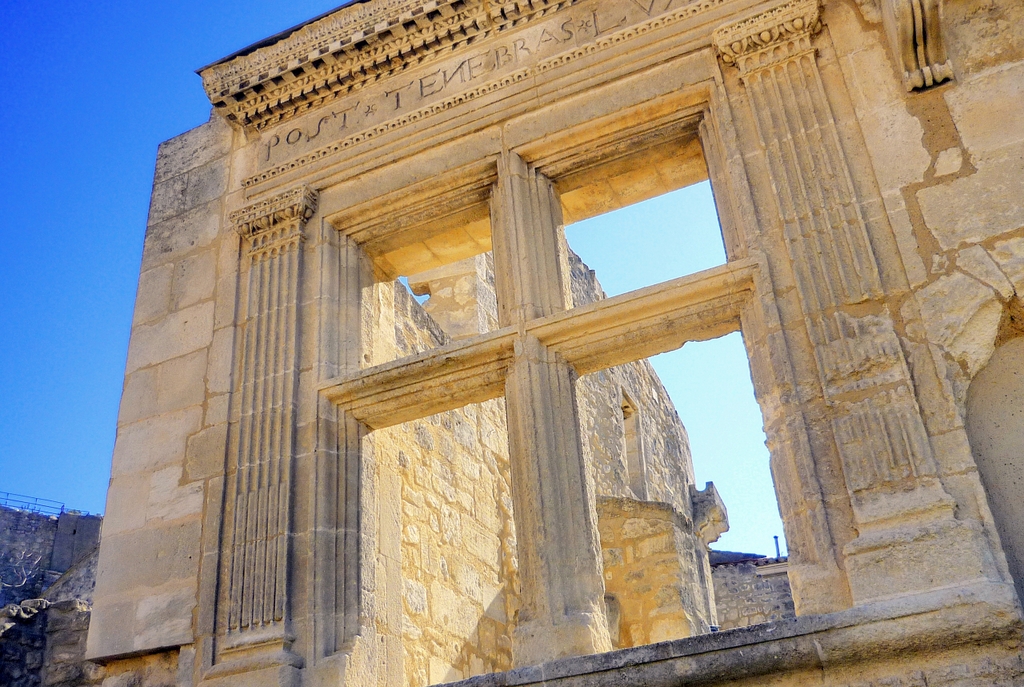
The only visible remains of the dwelling is a monumental Renaissance window which bears the Calvinist inscription:
“Post Tenebras Lux,” meaning “after the darkness, light.”
Adjacent is the public square of Place Prince Rainier III, named after the late Prince of Monaco, father of Albert II.
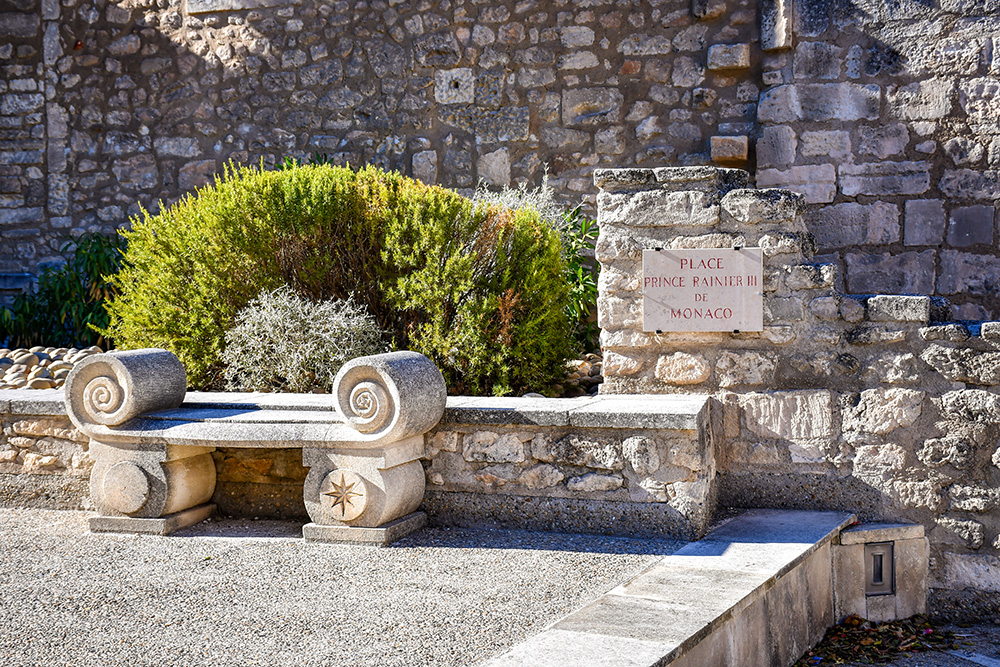
Hôtel de Porcelet
On the Rue des Fours, the Hôtel de Porcelet is a 16th-century residence with an original façade and elegant mullioned windows.
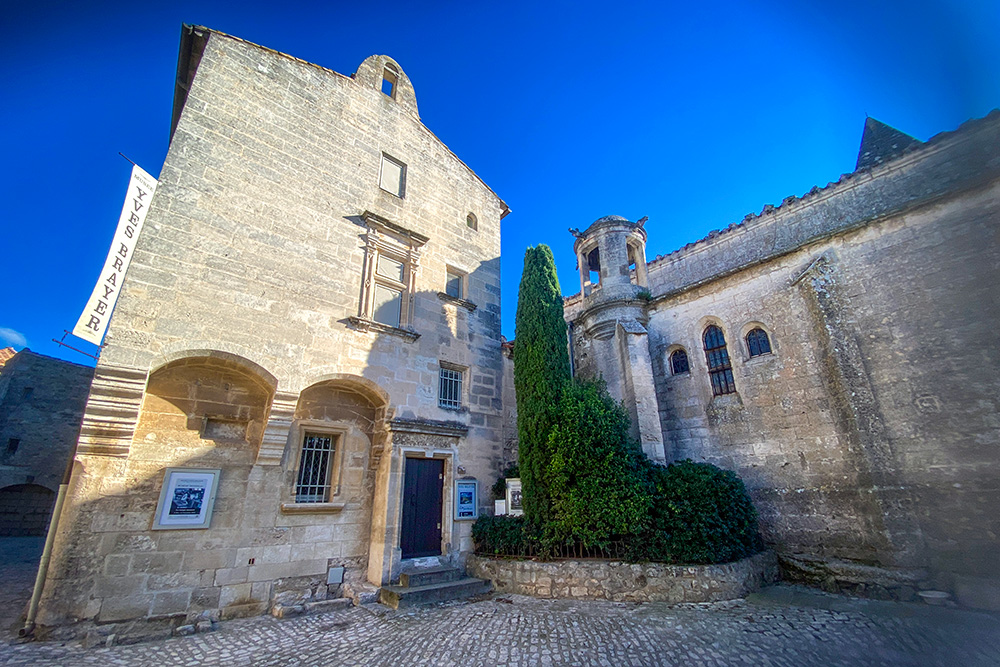
It houses the Yves Brayer Museum, where paintings by the figurative artist dedicated to Spain, Italy, and Morocco are displayed.
Place Saint-Vincent
From the square is a magnificent view over the valley.
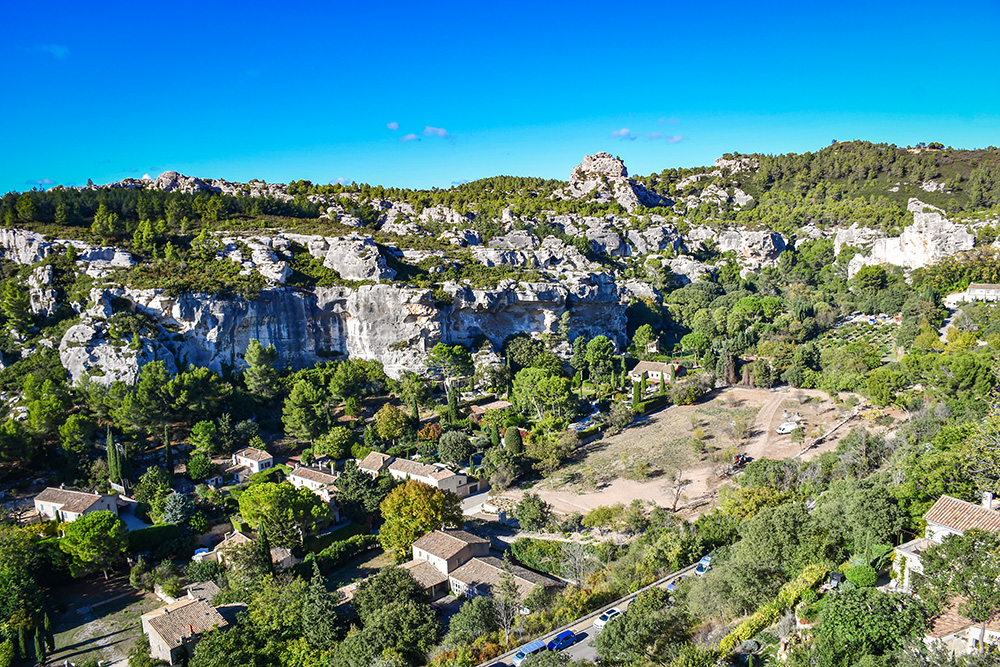
Two sanctuaries border the square of Place Saint-Vincent:
Chapel of the White Penitents.
Situated on the church square, on the edge of the cliff overlooking the Vallon de la Fontaine, the chapel was built in the mid-17th century by the Confrérie des Pénitents Blancs (Brotherhood of the White Penitents).
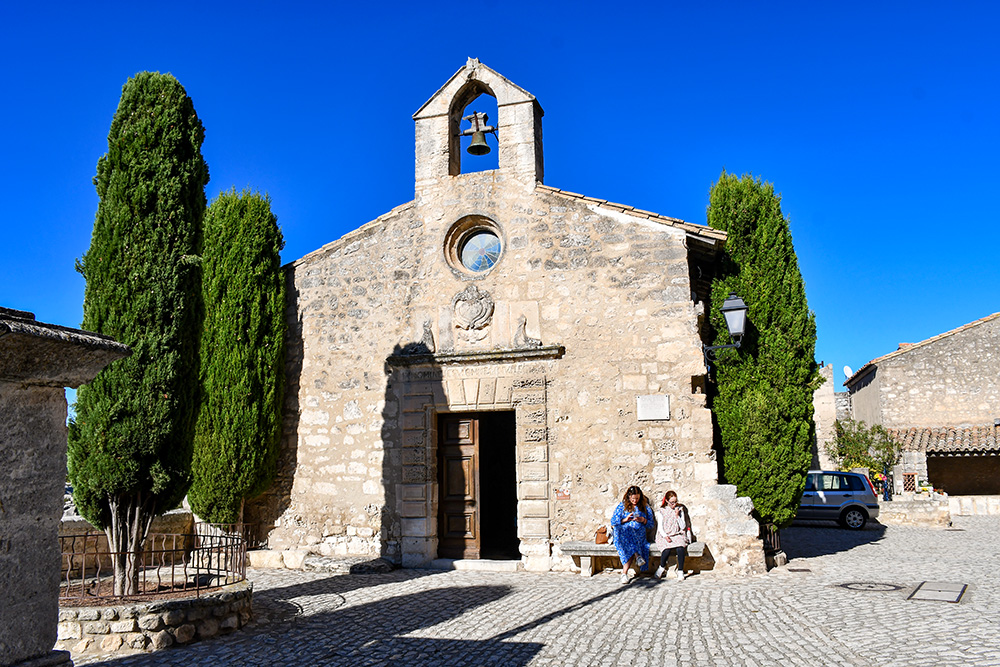
The chapel’s interior is decorated with a fresco by Yves Brayer, dating from 1974. It depicts the Christmas of the Shepherds in the Provencal tradition.

Eglise Saint-Vincent
The St Vincent church is one of the oldest buildings in Les Baux.
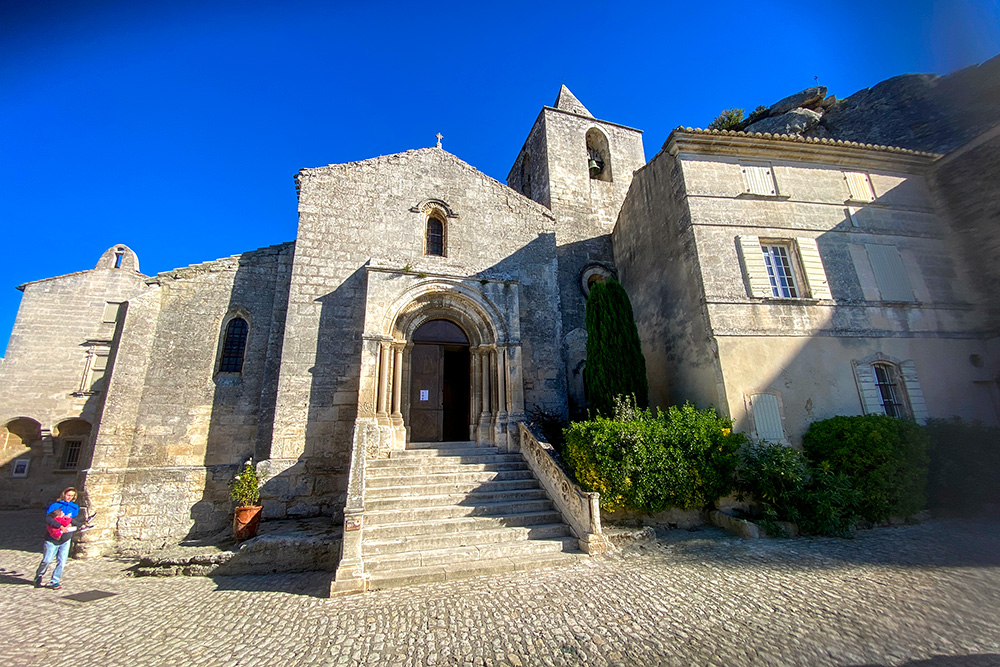
Its 12th-century Romanesque nave and ribbed barrel vaulting are among its features. The interior is partly carved into the rock.
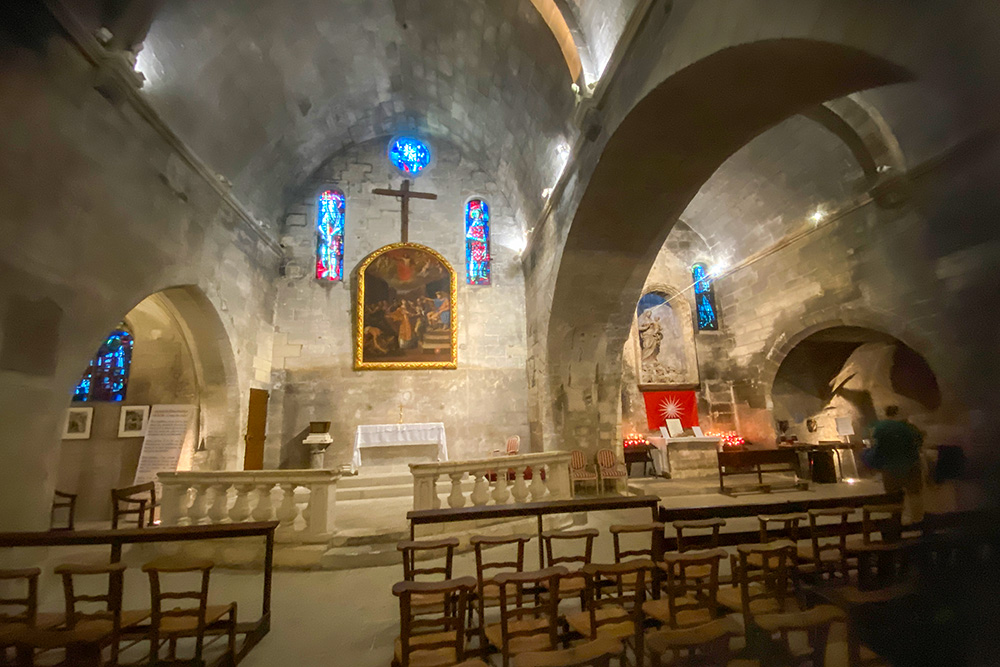
In 1609, the nave was extended in the Renaissance style, and modern stained-glass windows by Max Ingrand were added in 1960 as a gift from Prince Rainier III of Monaco.
To the church’s south stands a circular turret (lanterne des morts), topped with a dome decorated with gargoyles. Traditionally, a fire would be lit in the turret each time a local died.
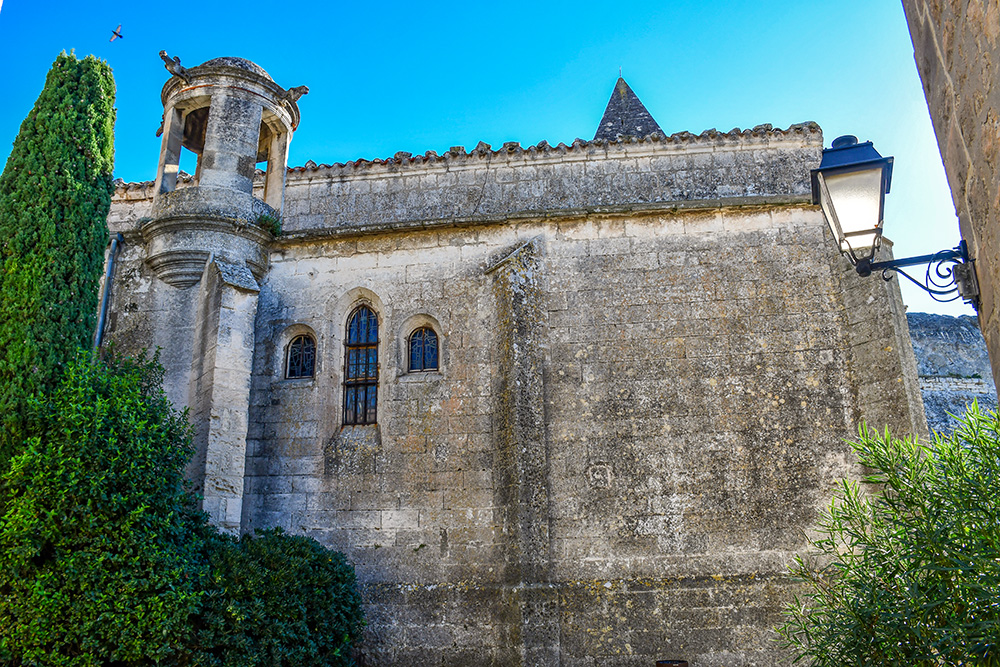
The Castle Esplanade
Access to the prow of the rocky spur of Les Baux (Esplanade du Château) is free and offers spectacular views of the neighbouring of Les Baux, as far as the Camargue and the Mediterranean Sea. If you can’t make it to the castle, visit this site at least!
Saint Blaise Chapel and the cemetery
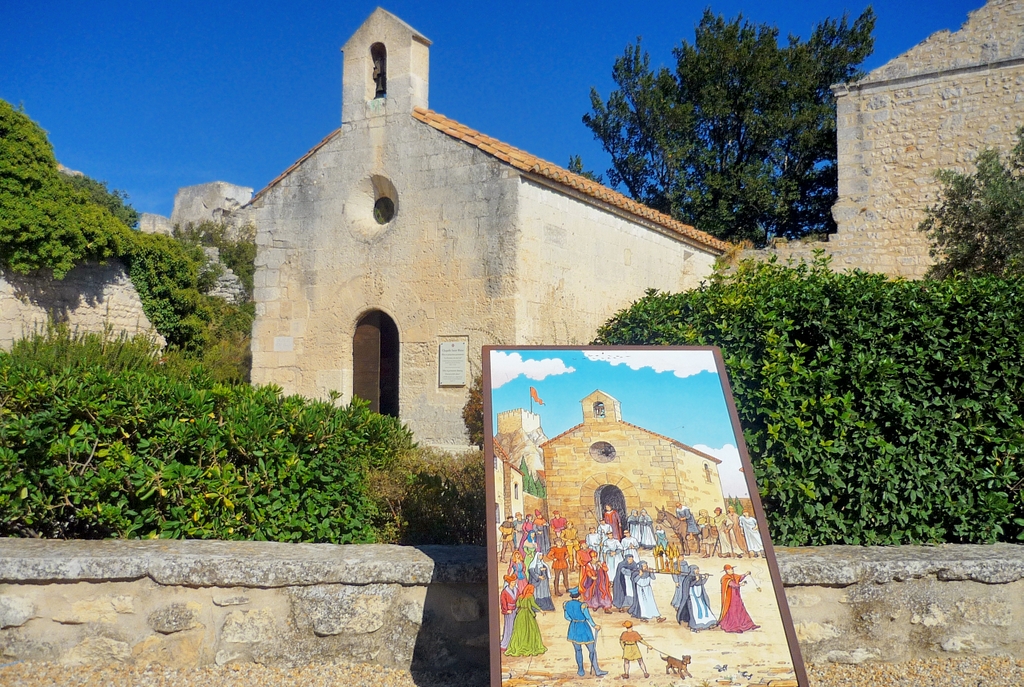
Located near the castle’s entrance, the Chapel of St. Blaise was built in the 12th century by the guild of wool carders and cloth weavers. Beautifully preserved, the building is a good example of Romanesque architecture in Provence. Inside, the film “An aerial view of Provence” runs on a loop.
Don’t miss the old cemetery opposite the chapel, which overlooks the Vallon de la Fontaine (Fountain Valley).
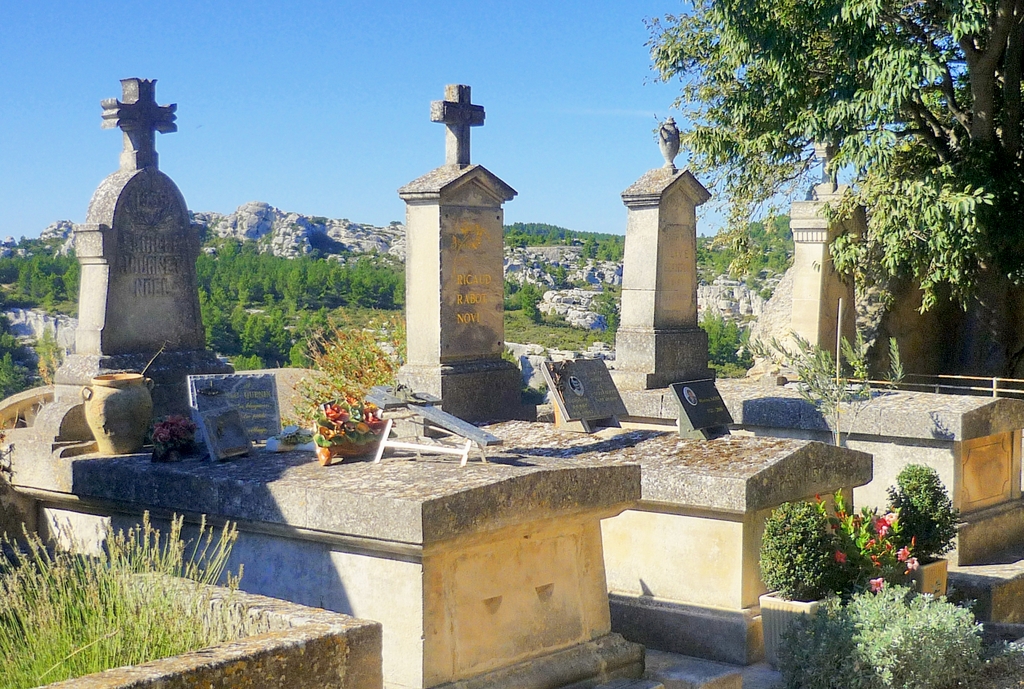
Some illustrious local people are buried here: Provencal painter Yves Bayer and poet André Suarès (1868-1948), who was also a friend of André Gide, Paul Claudel and Charles Péguy.
The impluvium
Notice the “Plan dallé” behind the windmill.
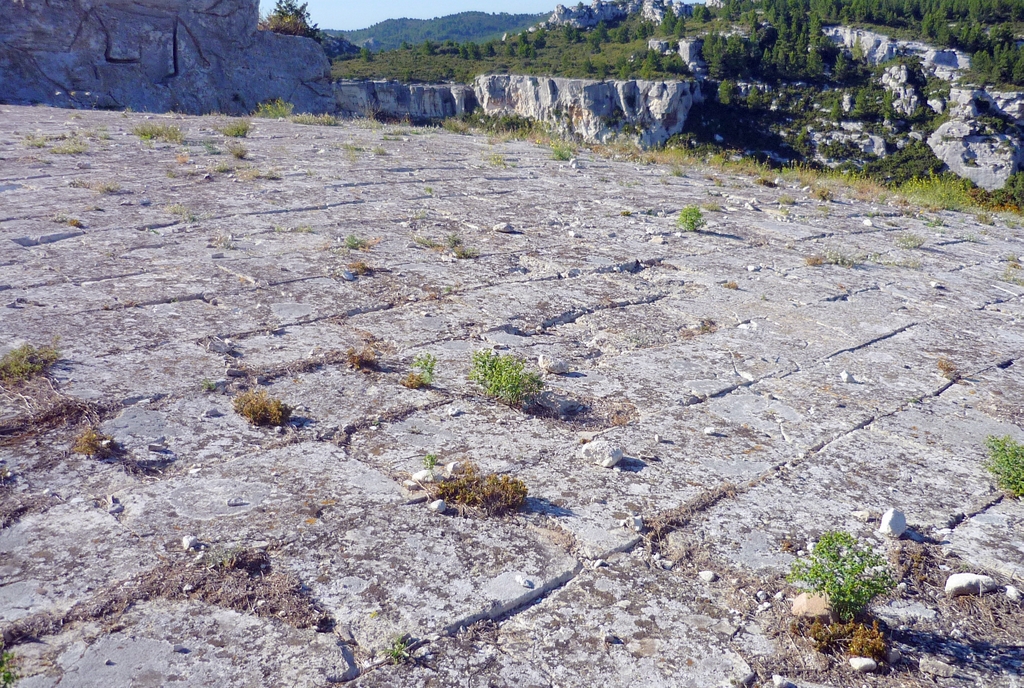
This sloping paved area is an impluvium used to collect rainwater to supply the village.
On this windy hillside, a flagstone area was designed as a water conduit to lead rainwater overflow towards a cistern.
The Windmill
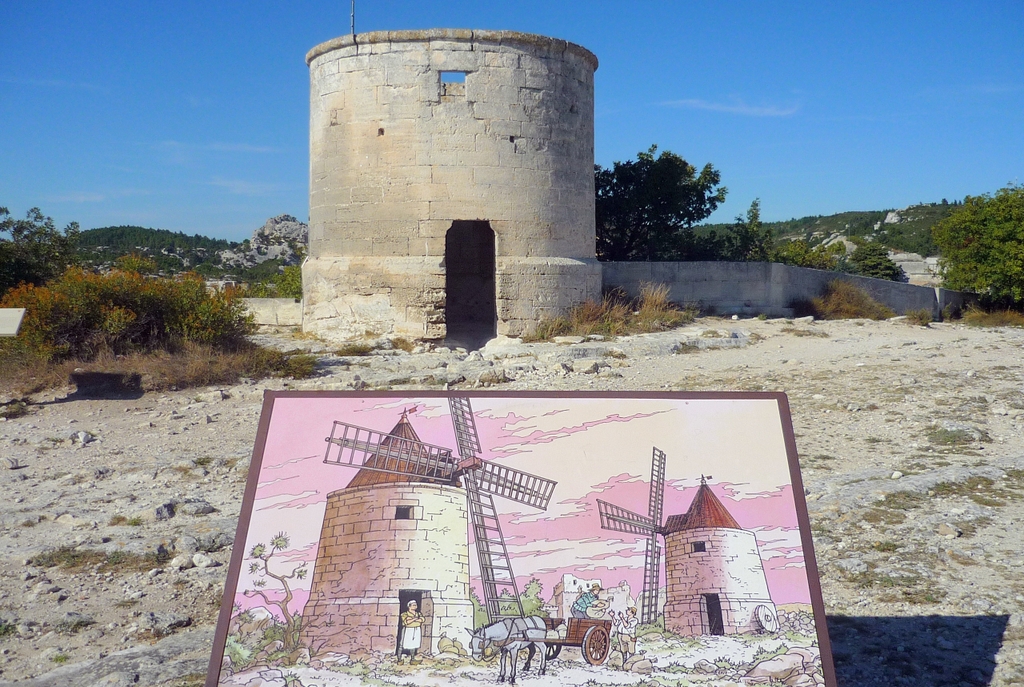
Three windmills operated on the prow of the rocky spur. The old windmill from 1652 is the only one that has survived.
As a windmill was a feudal privilege, the lord of Les Baux used to receive a small tax from the local farmers who used it, who would come up to the castle with their donkeys loaded with wheat ready to be ground into flour. The windmill evokes the famous work of Provençal writer Alphonse Daudet: Les lettres de mon Moulin (Letters of my windmill).
Charles Rieu Monument

The statue at the top of the promontory was erected in 1930 and is dedicated to Charles Rieu, nicknamed in the Provençal dialect “Charloun dou Paradou” (1846-1924). Native from nearby Paradou, Charles Rieu was an influential Provençal poet and singer whose Chants du Terroir (Songs of the Land) were published in 1897.
The orientation table
The orientation table faces a stunning panoramic view at the end of the rocky spur. We can see the region of Arles and the Camargue, the Plain of Crau, the Étang de Berre, the Mediterranean Sea, and the mountains in front of Marseille. In the distance, you can spot the Montagne Sainte-Victoire to the east and the west, the walled town of Aigues-Mortes and as far as Mont Saint-Clair in Sète.
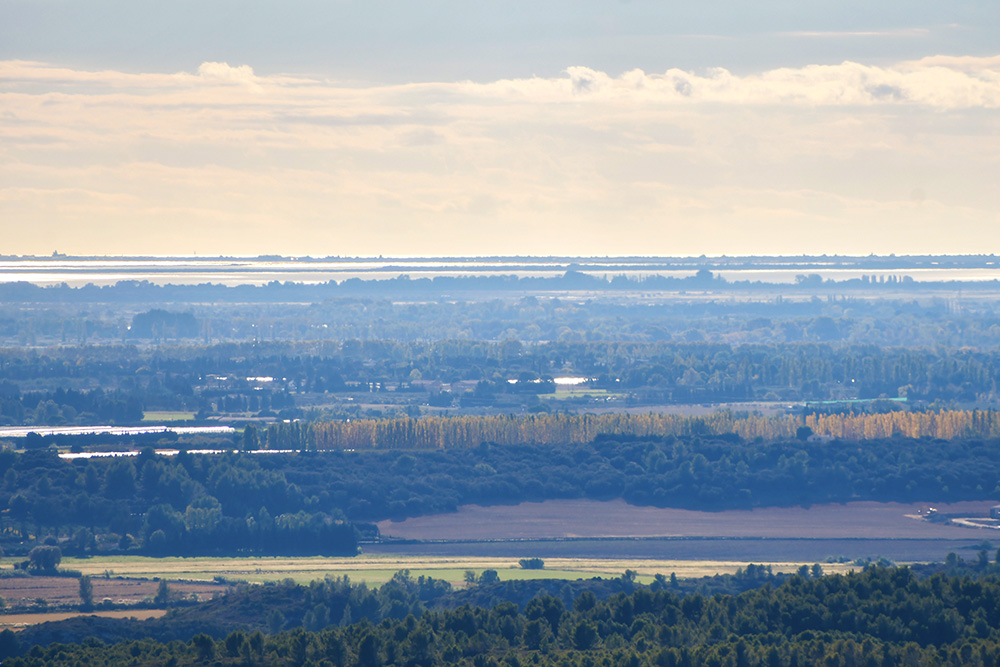
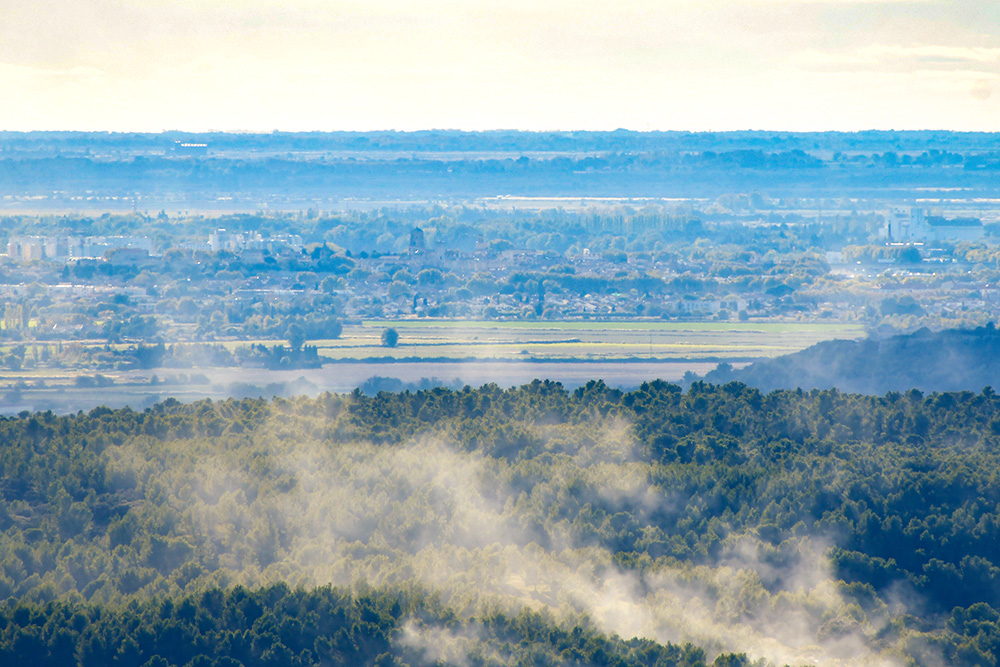
On your way back to the citadel, you will walk along the ridge of the rocky outcrop of the plateau, with magnificent views over the Entreconque Valley, with its rows of olive trees and vineyards.
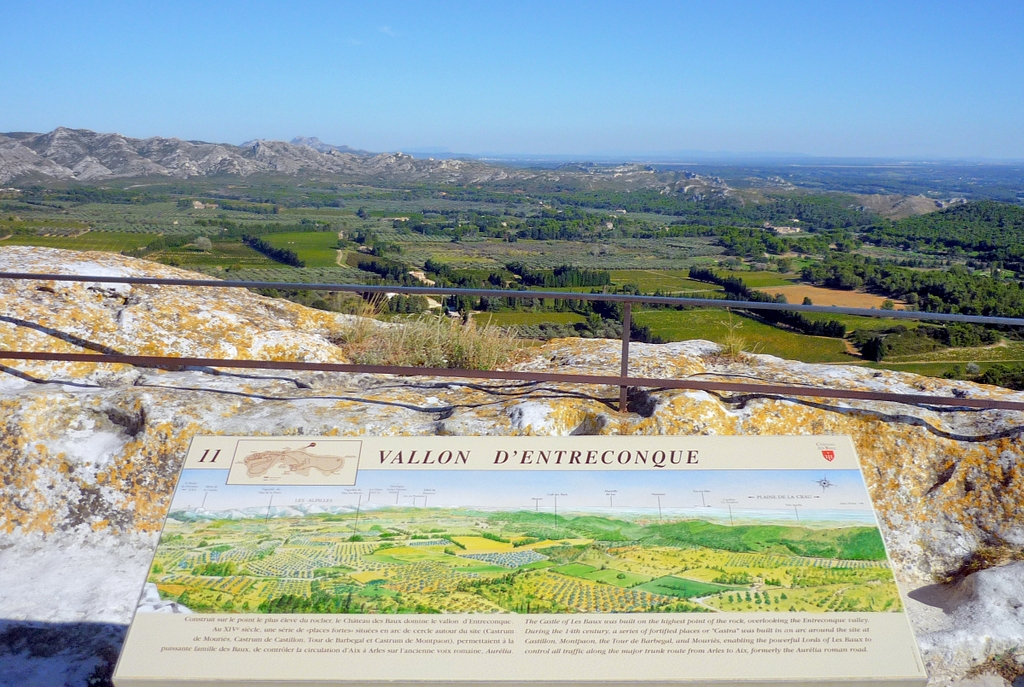
The Castle of Les-Baux
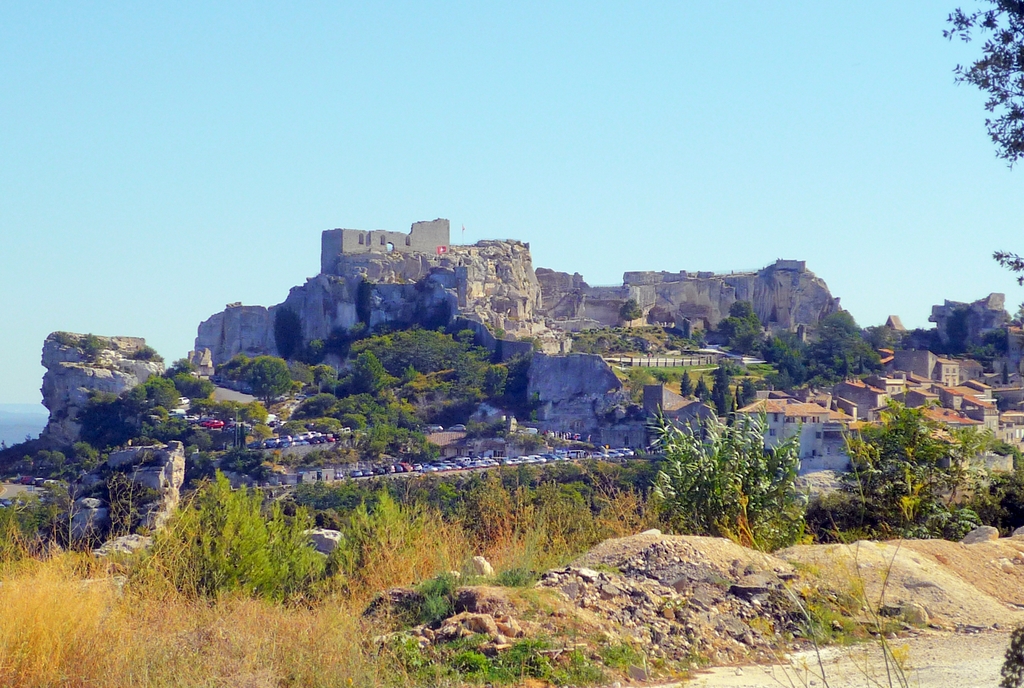
Above Les Baux-de-Provence sits the “Citadelle des Baux”, the ruined castle of the village. The fortress is hardly distinguishable from the plateau’s edge on which it was built. Nevertheless, it still features remnants of its turbulent past: the dominating keep, the Saracen Tower (taking its name from the Saracen raiders who came from the South), and the Paravelle tower (used as a lookout tower).
The plateau and the entrance
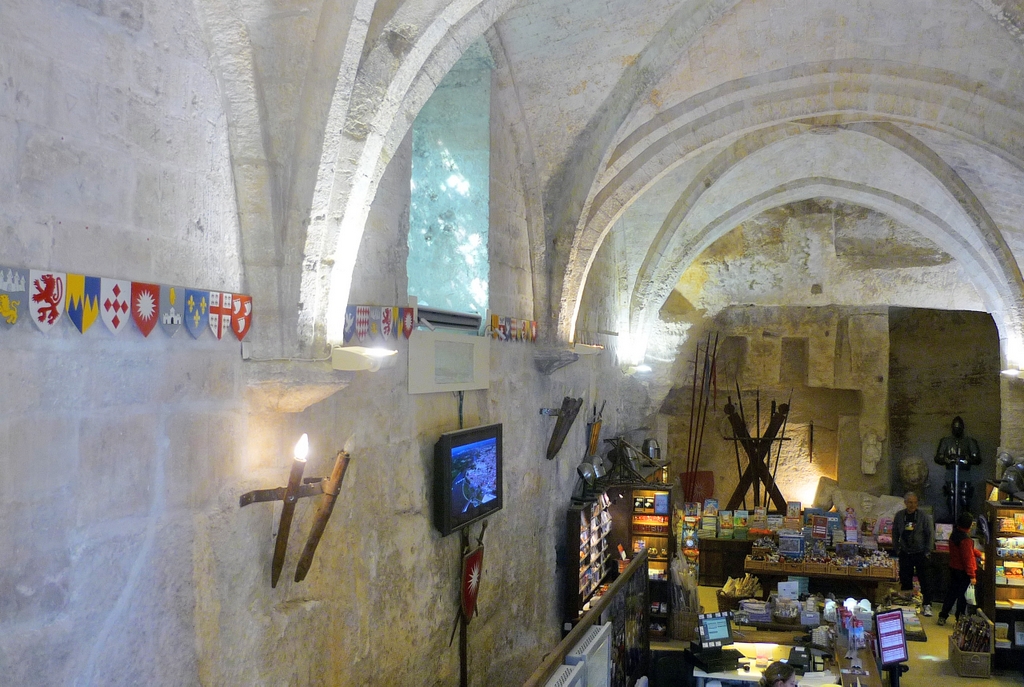
The plateau on which the castle extends covers an area of 7 hectares. A visit to the whole domain takes at least 1.5 hours and should be avoided in summer when the hordes of tourists make the visit less enjoyable.
Until recently, the castle’s entrance was located at the end of rue du Trencat in a building which displays two interesting models of what the castle looked like in the Middle Ages. There is also a gift shop where you can find some interesting books about Les Baux. Audio guides in English are available if you wish to know more about the castle’s history and occupants.
The new entrance is next to the St Blaise Chapel and the former Quiqueran Hospital.
Throughout your visit, you will find information panels explaining the site’s important landmarks, some with helpful reconstituted images of how the castle used to look in the Middle Ages.
Quiqueran Gardens
Once we got past the ticket office, we began visiting the Gardens of Quiqueran.

This is a new garden, nestled within the walls of the village’s ancient arena and at the foot of the ruins of the 16th-century charity hospital.
The garden draws inspiration from medieval garden principles, which are full of symbols and partitioned into different spaces, each offering a unique atmosphere. It features plants and shrubs typical of the Provençal garrigue: thyme, rosemary, and orchard fruits.
The Quiqueran Hospital
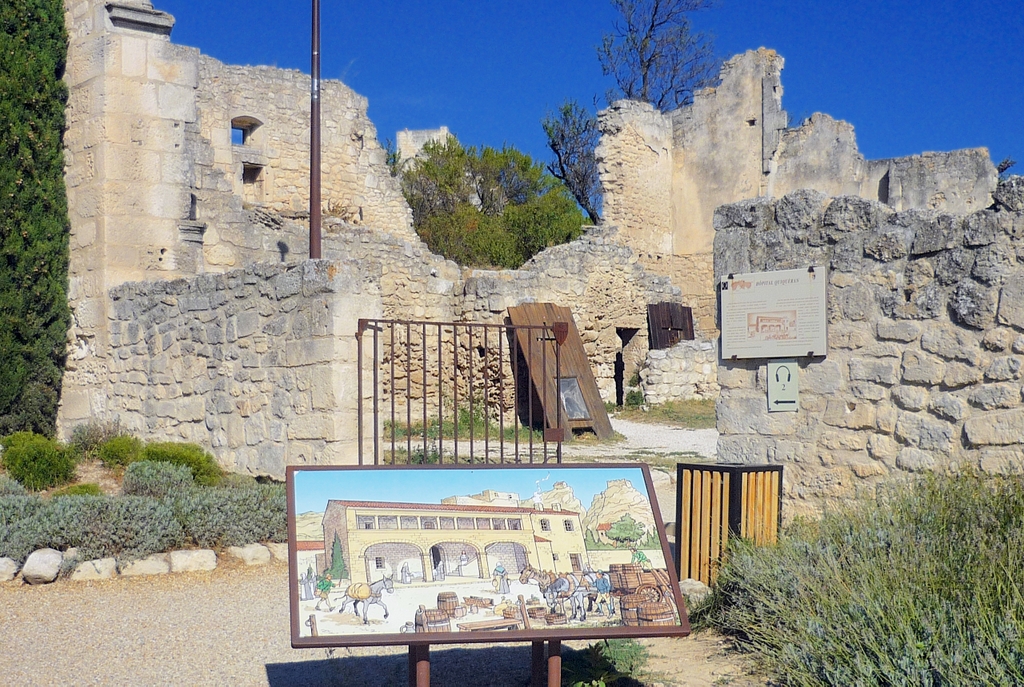
Adjacent to the gardens and next to Saint Blaise Chapel, the Quiqueran Hospital was built between 1542 and 1583 by Jehanne de Quiqueran, the wife of Honoré des Martins, Governor of Les Baux.
The hospital for the poor and the sick was closed in 1787 and transferred to the Maussane Hospital, which still houses its archives today.
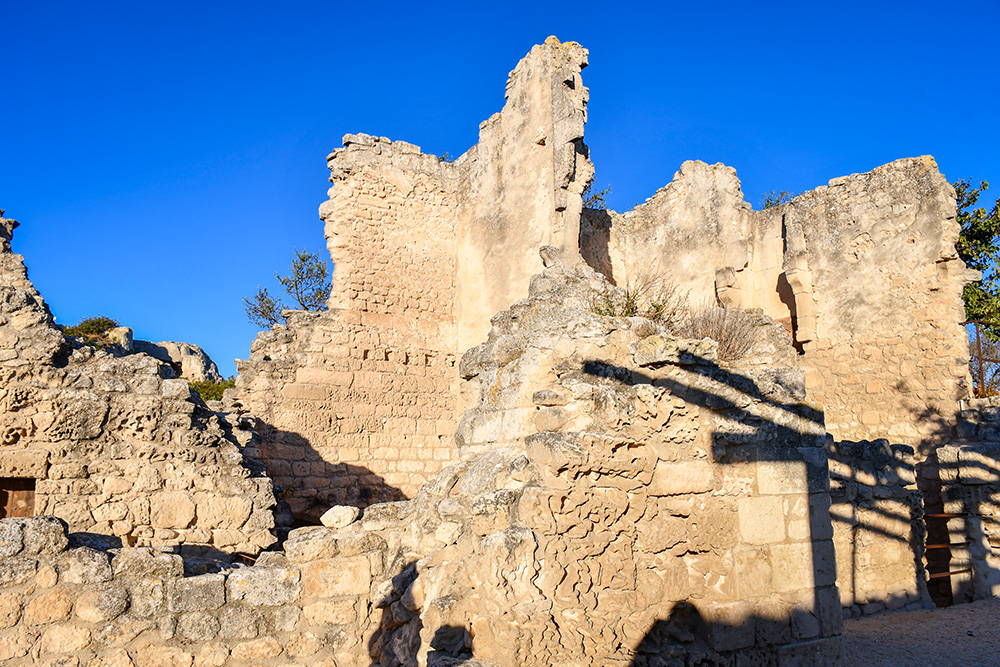
The siege machinery
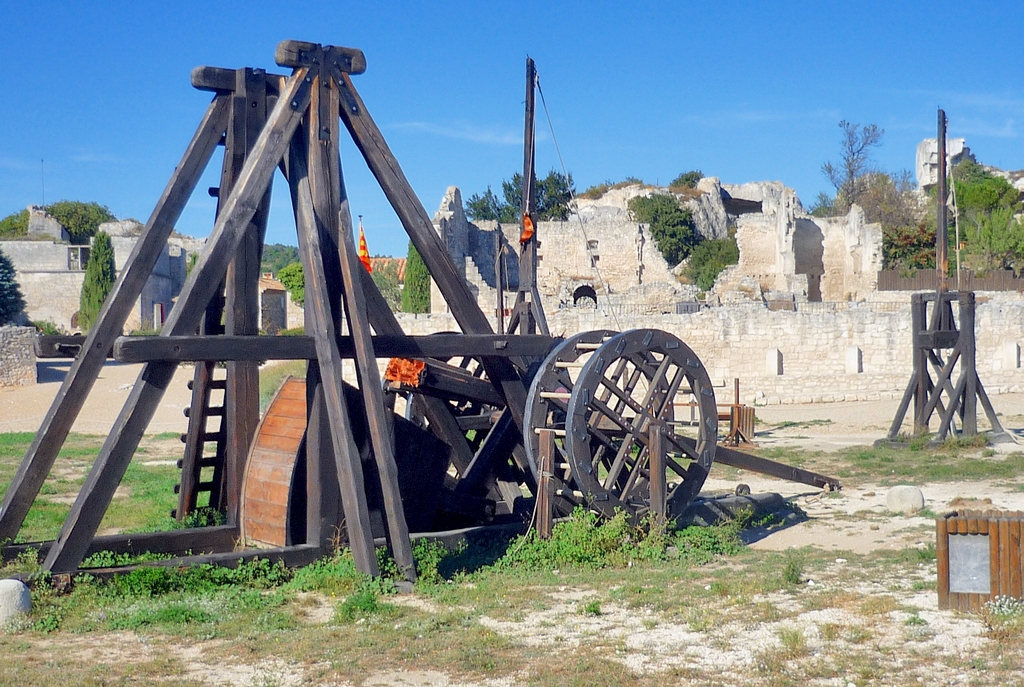
One of the most popular attractions of the castle is the permanent exhibition of siege machines, some of them still in operation. These war machines were built from 13th-century sketches drawn to full-sized replicas. They include the most giant trebuchet in France, 16 metres high, weighing 7 tonnes, with a firing range of 200 metres. The trebuchet could fire a load of boulders up to 100 kg, requiring 60 soldiers to activate it.
Other war machines included in the exhibition are a couillard (a sort of trebuchet with split counterweights and a rotating beam), a bricole (a rotating-beam stone-throwing catapult that also fires real projectiles), and a battering ram, which was used to break down the heavy gates of besieged castles.
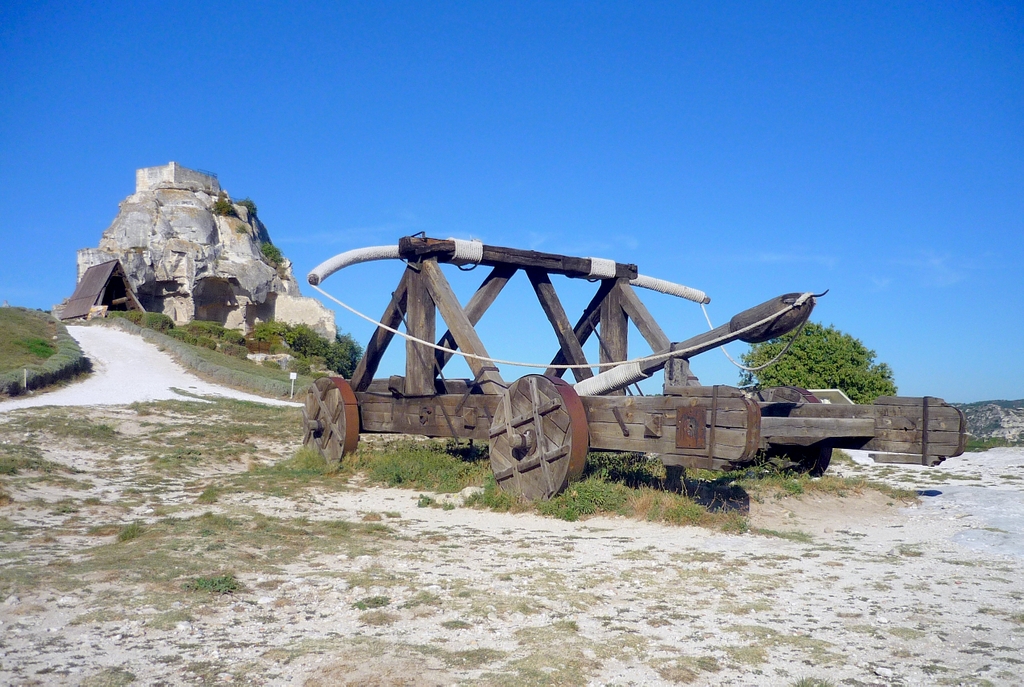
The catapults are fired every day between April and September at 11 a.m., 1.30 p.m., 3.30 p.m., and 5.30 p.m.
The Saracen Tower
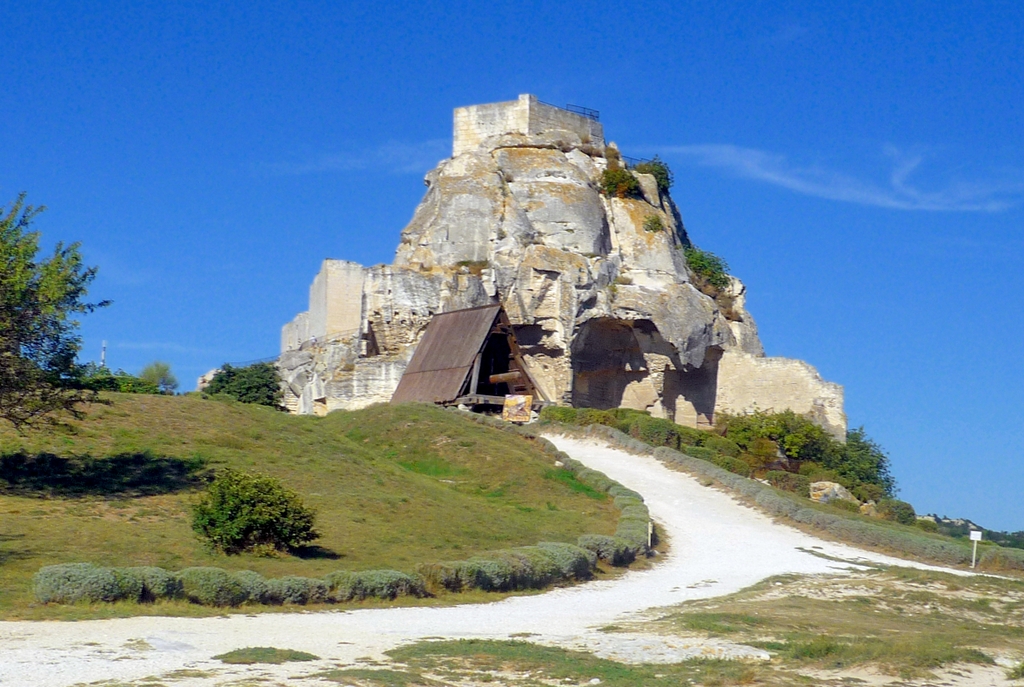
The first ruined part of the castle of Les Baux you will come across coming from the desolate plateau is the Saracen Tower (Tour Sarrasine) with a battering ram at its foot. Its name derives from the threat that Les Baux faced with an invasion of the Saracens. The tower was then part of an ingenious system of defence conceived to mislead the invaders they were to enter the citadel.
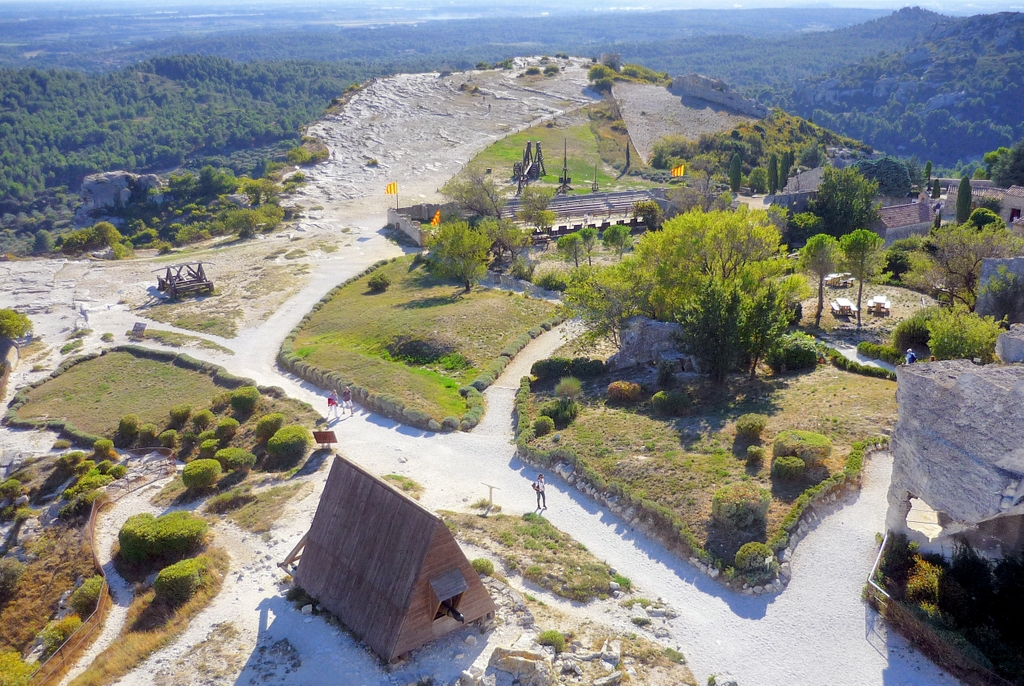
A flight of stairs allows visitors to climb the tower, rewarding them with spectacular views over the castle’s plateau, the Plain of Crau, and Arles.
The Second Outer Courtyard

Called “Seconde Basse Cour” in French, it includes a ruined 16th-century house with a paved floor, the remnants of a chimney and two vaults dug into the rock at the back on the right.
The Rabbit Burrow
Called in French “Trou aux lièvres”, it consists of a sloping passageway with wide steps that close the access to the castle from the village.
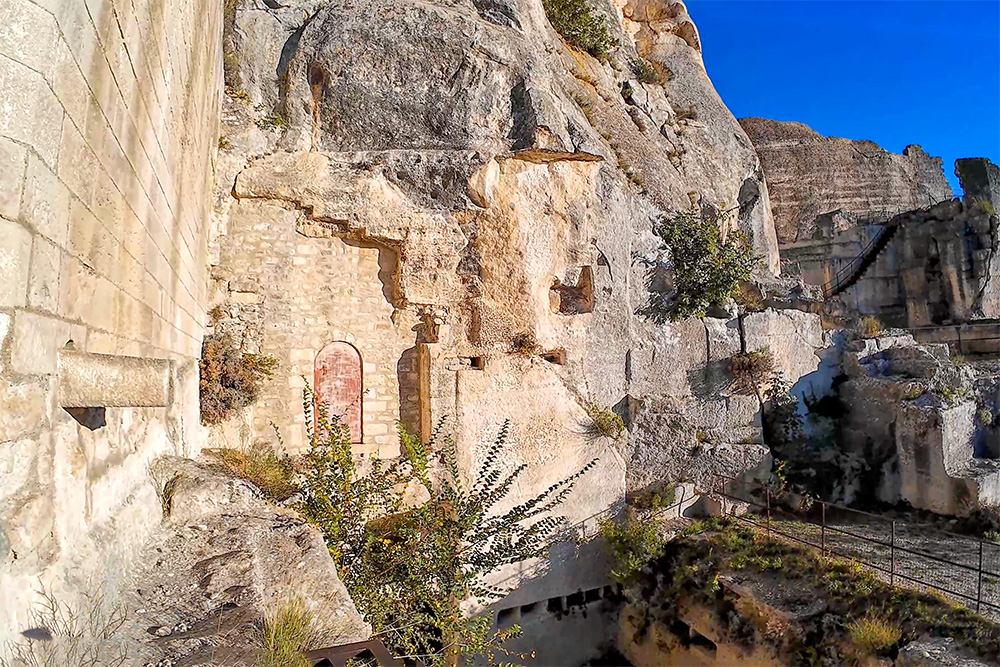
The first outer courtyard
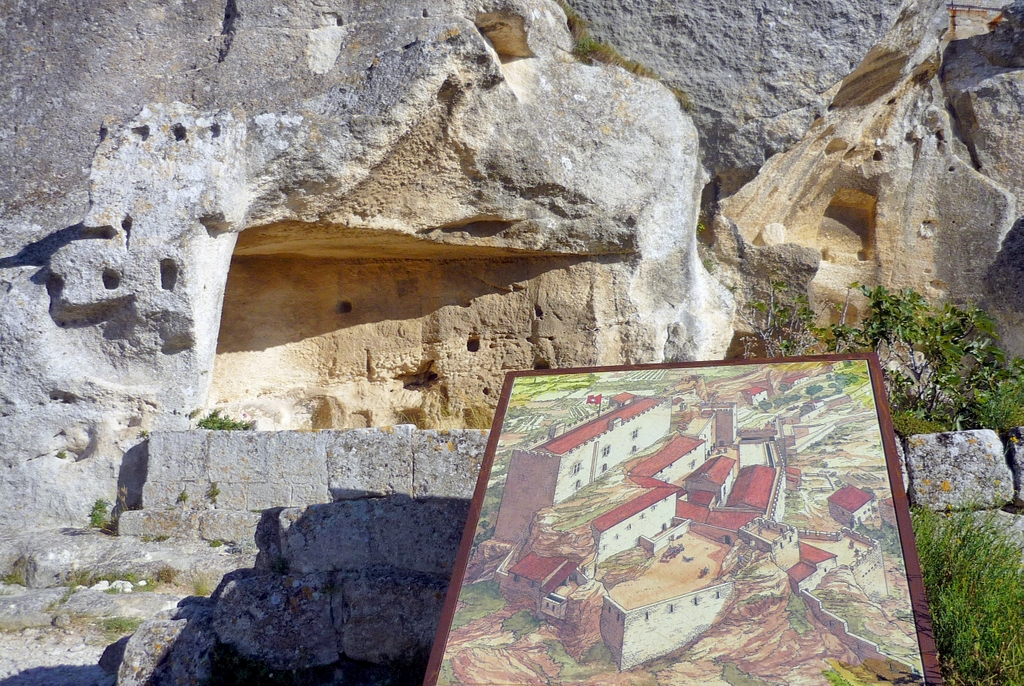
Known as “Première Basse Cour”, this is where the Lords of Les Baux entered their residences and where the guards lived.
The Castle chapel
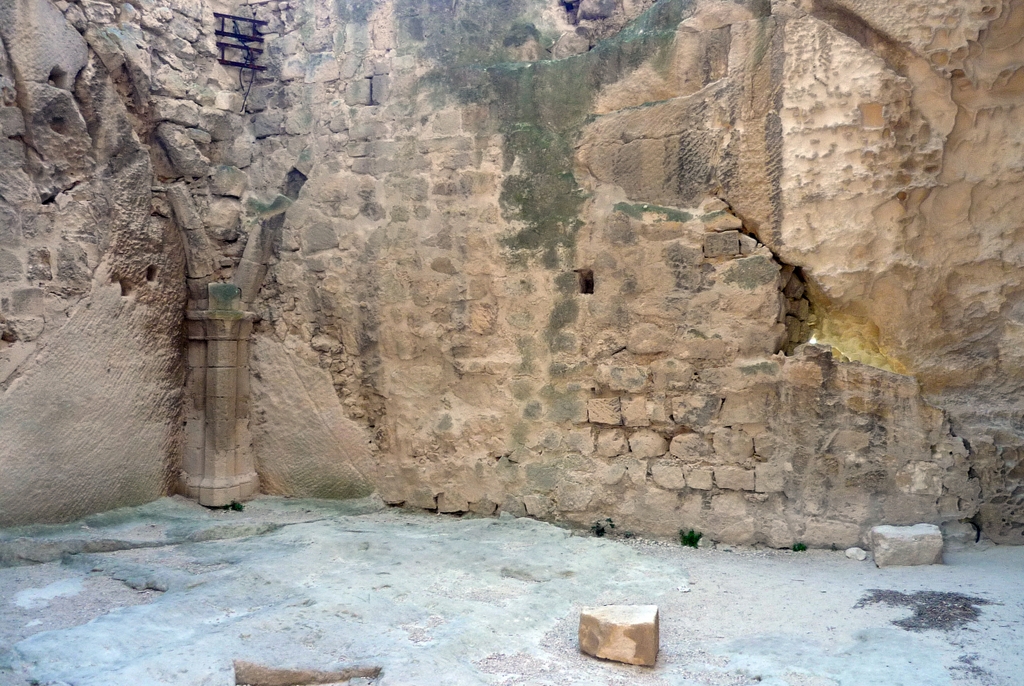
The castle chapel (12th-16th centuries) is located near the keep. Also known as “Saint Catherine’s Chapel”, it features rib-vaulted bays.
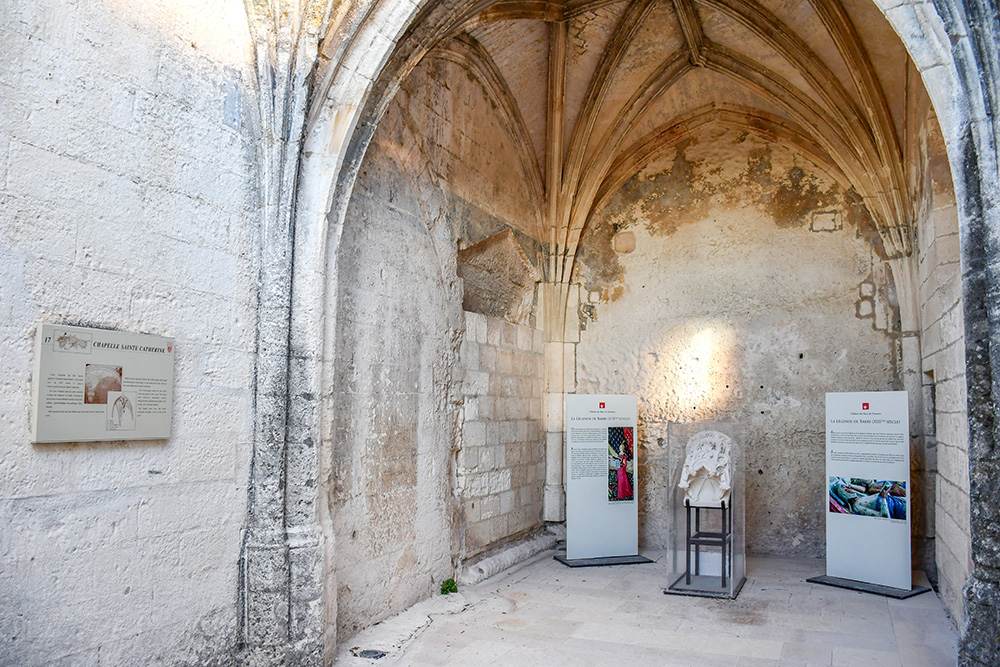
The Bakehouse
The “Maison du Four” spread across three rooms on the ground floor provided a shelter for the oven and a sink with a drainage hole. Look out for the window and its mullions and transoms that open onto the castle’s main interior street.
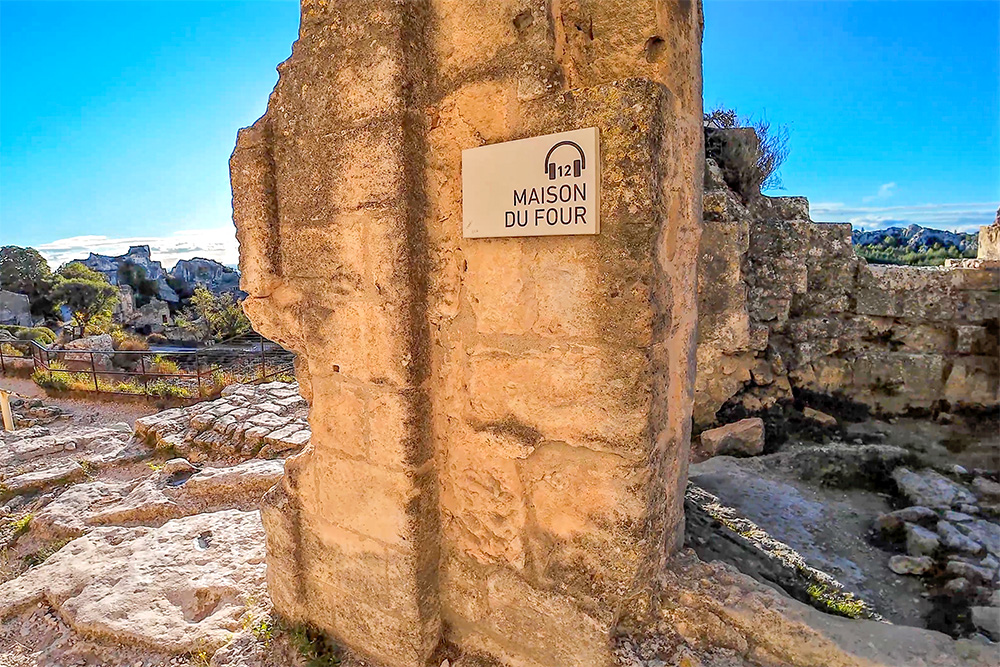
The Pigeonholes
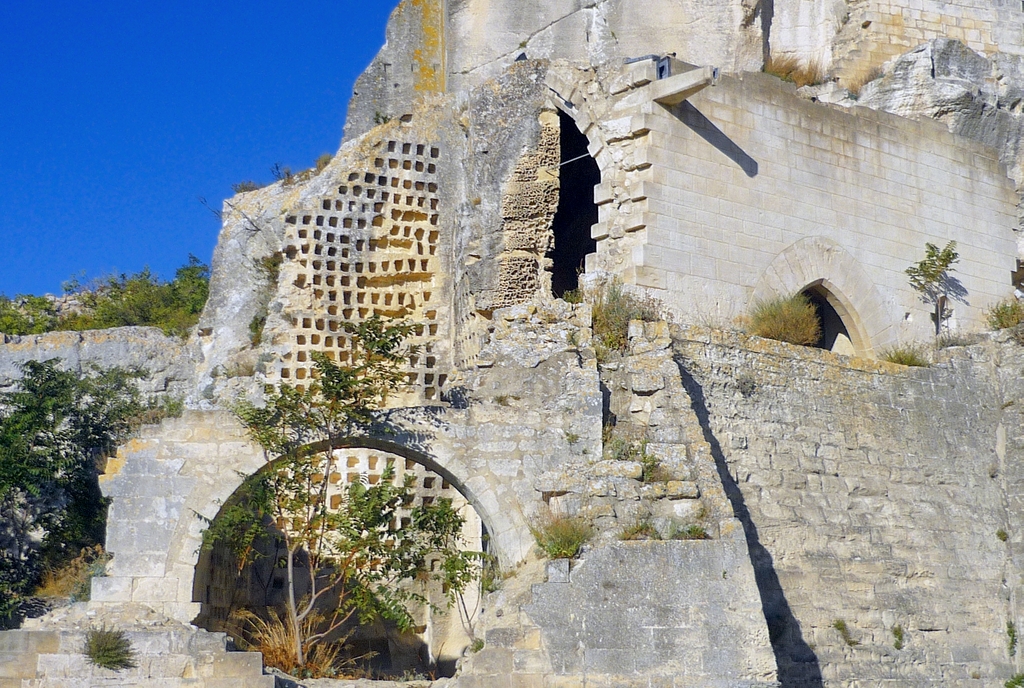
Built simultaneously as the keep, the dovecotes have been singularly carved on the rock wall. Over 2,000 pigeonholes were carved out, and the birds’ eggs were collected using a ladder.
The Keep

The best remnant of the military architecture of Les Baux Castle, the keep was built at the highest point of the plateau, overlooking the whole citadel.
The lower level houses one room while the second has three, all shaped from the rock.
While exploring the castle, the visitor can see traces of structures that used to make it an impregnable fortress: arches, doors and windows, holes (where beams were previously fixed), sculpted corbels…
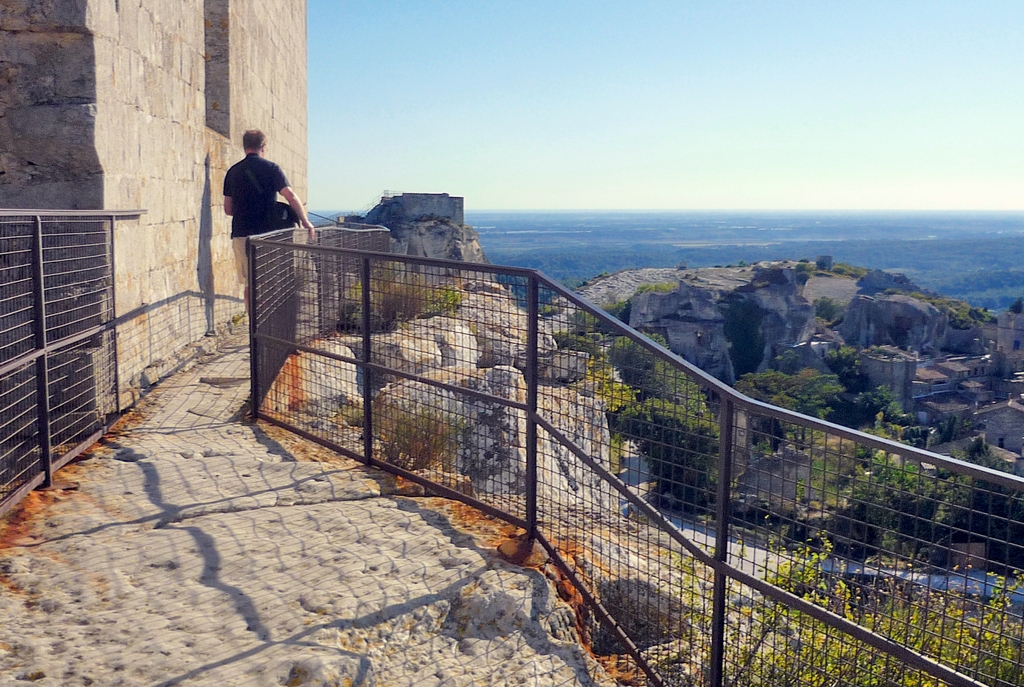
The keep is accessible by a giddy and difficult stairway, and the view from its top is one of the most impressive in Provence.
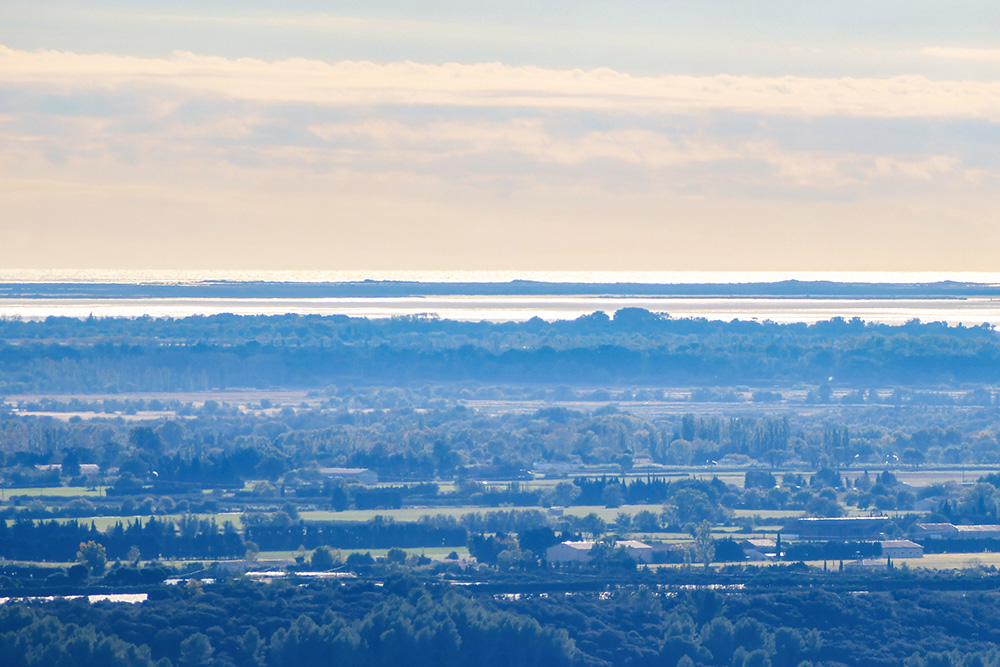
The Paravelle Tower

Opposite the keep, the Paravelle Tower has been built on top of a rock at a corner of the outer walls. From its top, the view stretches to the Fontaine Valley and the Val d’Enfer.
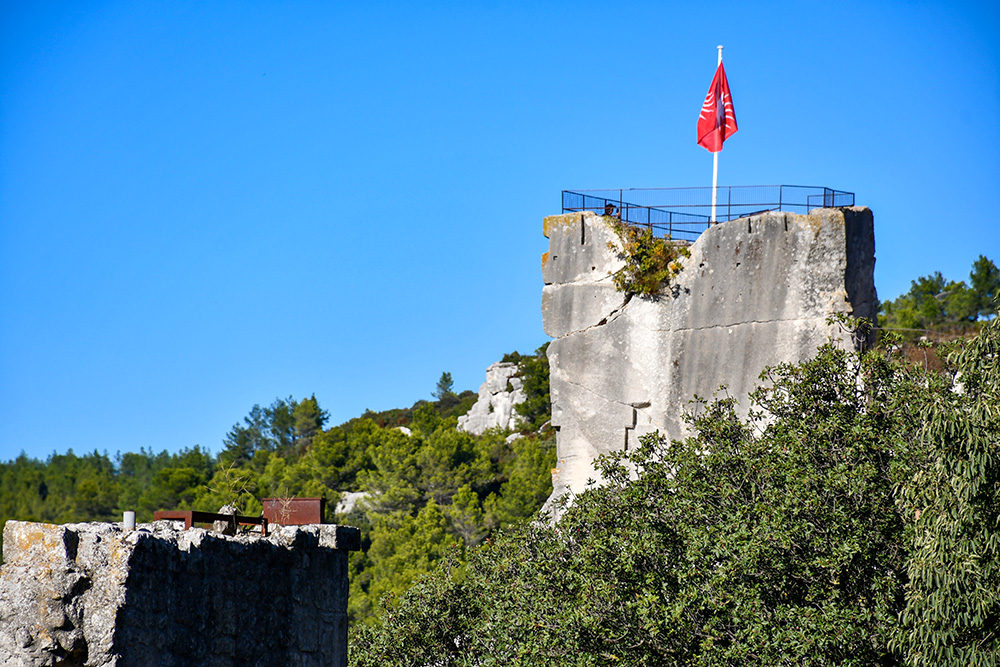
Troglodyte Houses and End of Visit
To end your visit, head towards the exit via the Trogodytes Rooms.
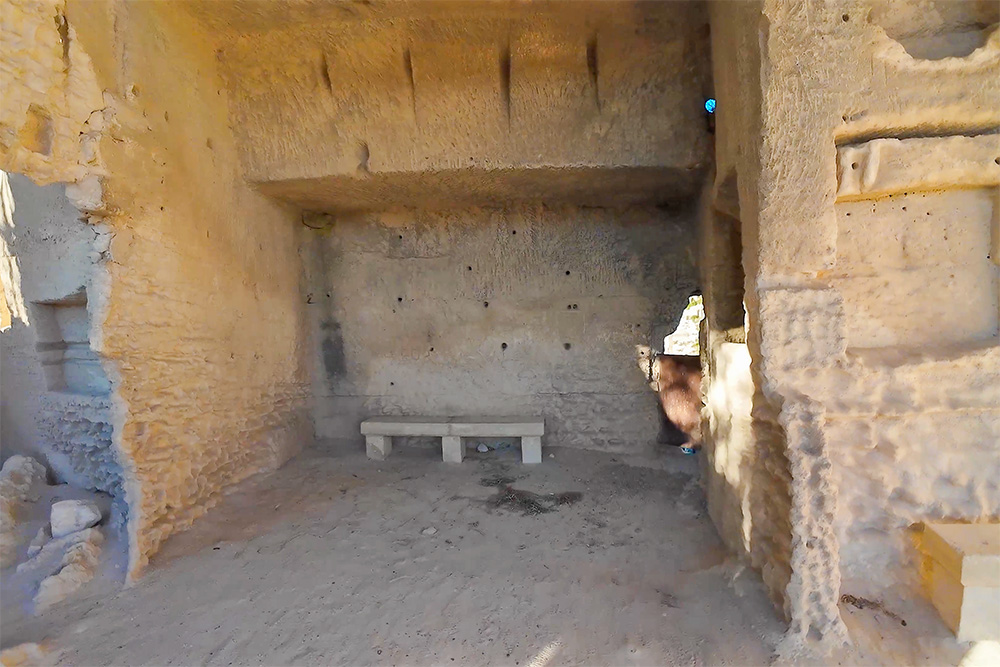
These cave dwellings bear witness to the ingenuity of the inhabitants of Les Baux, who used the stone to make their homes more functional.
We took the time to look for clues like shelves moulded into the wall, fireplaces fitted into the thickness of the rock, or handles for hanging equipment and drying ham.
Carrières de Lumières
The Val d’Enfer (Valley of Hell) is within walking distance from the village. It is the site of old quarries. One of them houses the original permanent exhibition ‘Carrières de Lumières’ (formerly ‘Cathédrale d’Images’). Opened in 1977, the show is located on the site of an abandoned limestone quarry.
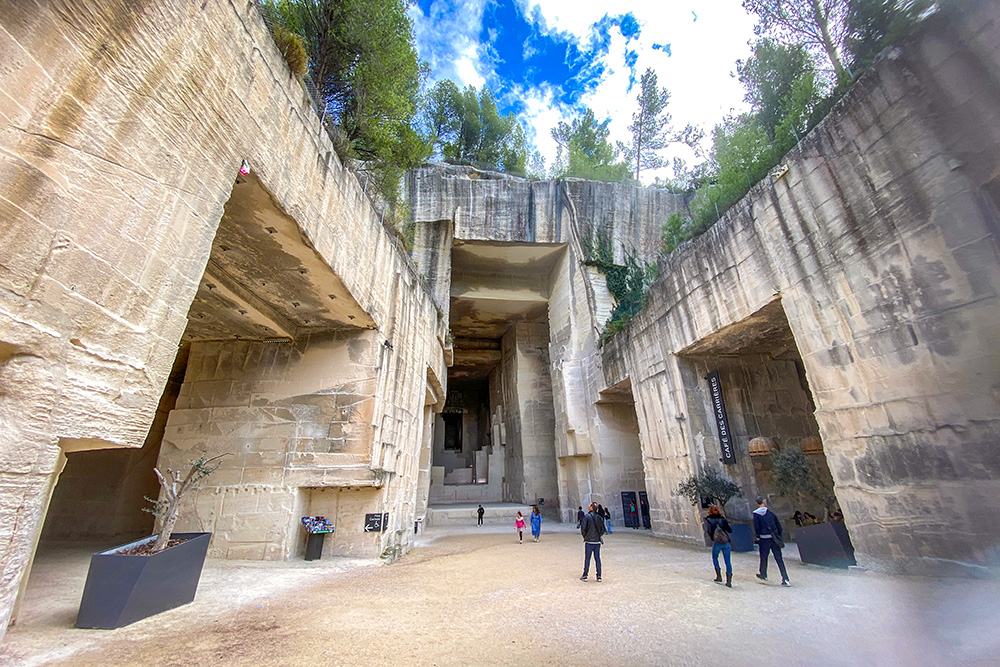
To the right of the entrance, a large gallery leads you under the mountain towards a huge hall divided by massive pillars. There, 4,000 square metres of walls and ceilings are used as natural screens to project astonishing, 12-metre-high images. Due to the uneven surface of the walls, these projected images can be viewed from various angles, and the visitors are encouraged to move around to observe them from another perspective.
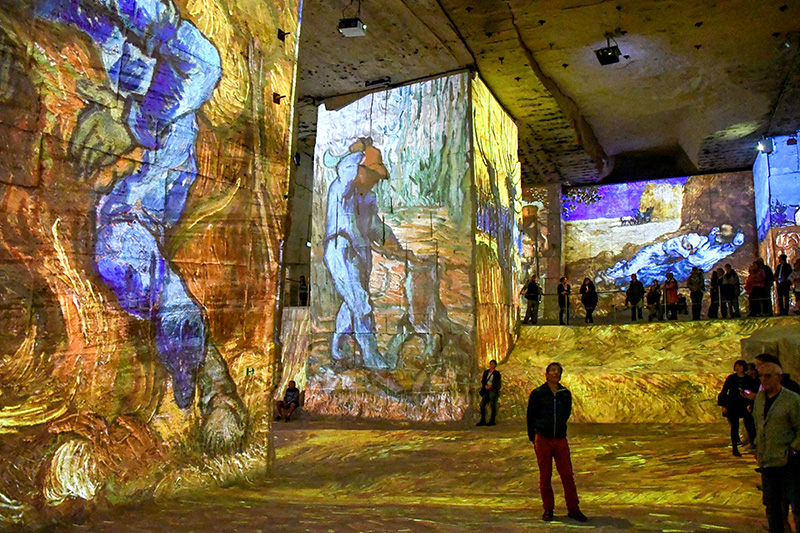
The 2010 show was created around Sydney and Australia, while in 2011, it focused on the life and the works of Leonardo da Vinci. In 2012, the show was called “Gauguin, Van Gogh, painters of colours”. The 2019-2020 exhibition was themed on Van Gogh’s Starry Night.
The show we saw in October 2023 included two projections:
- a short program, Mondrian, the architect of colours and
- From Vermeer to Van Gogh – the Dutch Masters.
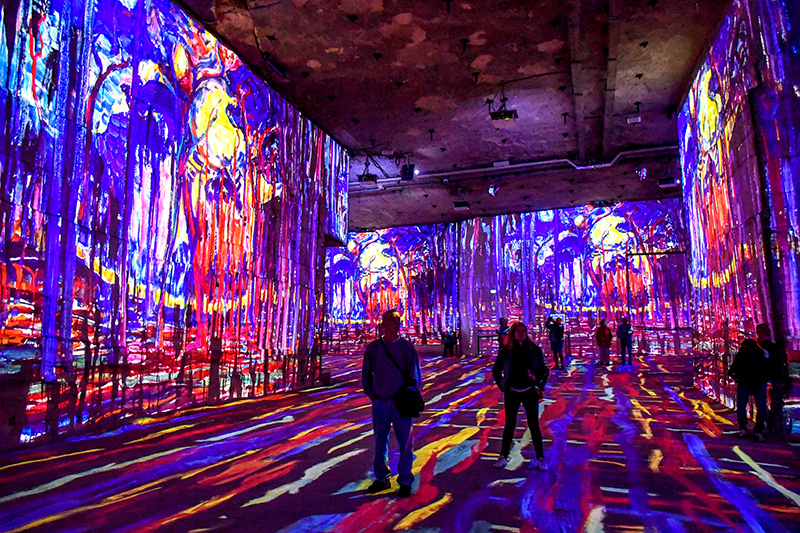
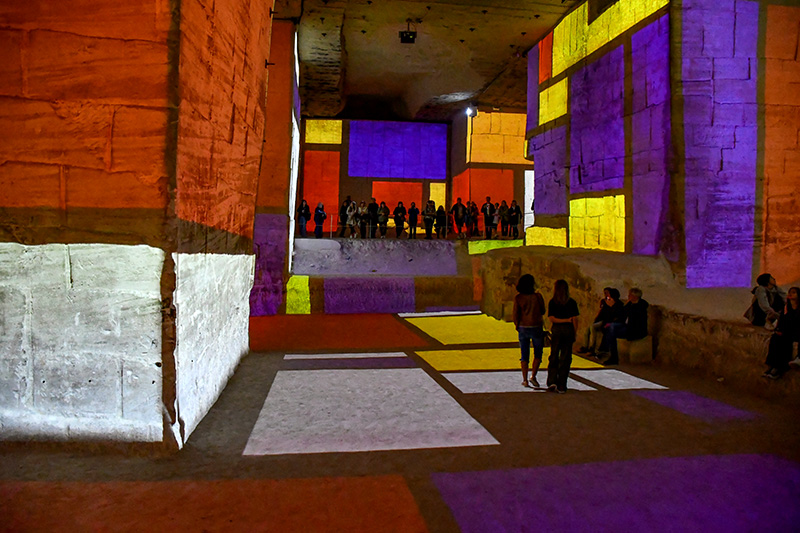
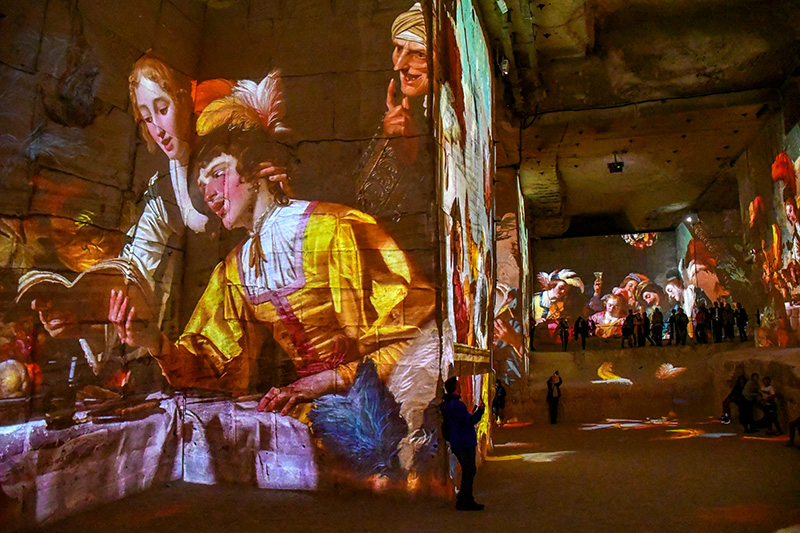
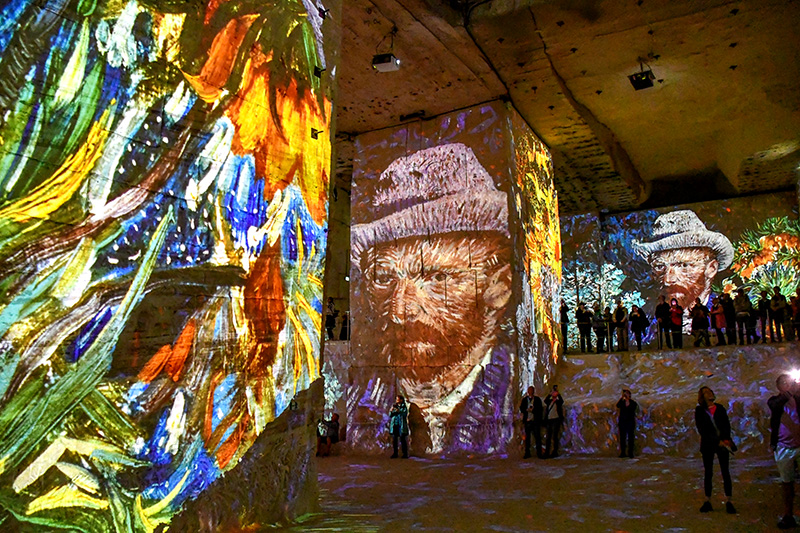

Visit the website of the Carrières de Lumières [in English].
How to get to the Alpilles and Les Baux

By car
The Alpilles are easily accessible by car from Provence’s main cities, Marseille, Arles, and Avignon, as well as from the cities of Nîmes and Montpellier through an excellent network of motorways, the French “autoroutes”.
By air
If you travel from Australia or America, you could fly to Paris Charles de Gaulle and travel by TGV from the airport station straight to Avignon or Aix-en-Provence and rent a car from there.
By train
The TGV from Paris-Gare de Lyon takes less than 3 hours to the TGV stations of Avignon and Aix-en-Provence. There are no train stations in Saint-Rémy-de-Provence or Les Baux-de-Provence. You’ll have to take a coach from Avignon or Arles to reach the region.
More info about Les Baux-de-Provence!
- a list of places where to stay in the region of Les Baux
- the old town of Saint-Rémy-de-Provence on the blog
- the Tourist Board of Alpilles en Provence
- the Tourist Board of the Provence region
- Check out my friend Ellen’s post about her visit to Les Baux!
Pin it for later!
Did you enjoy reading about Les Baux? If so, please share this article on Facebook or X (formerly Twitter), and pin it on Pinterest:






It stole my heart, too, Pierre. And like you, I could easily return. There are so many beautiful villages in that part of France and you’ve captured them so well in your photos!
Merci beaucoup, Ellen!